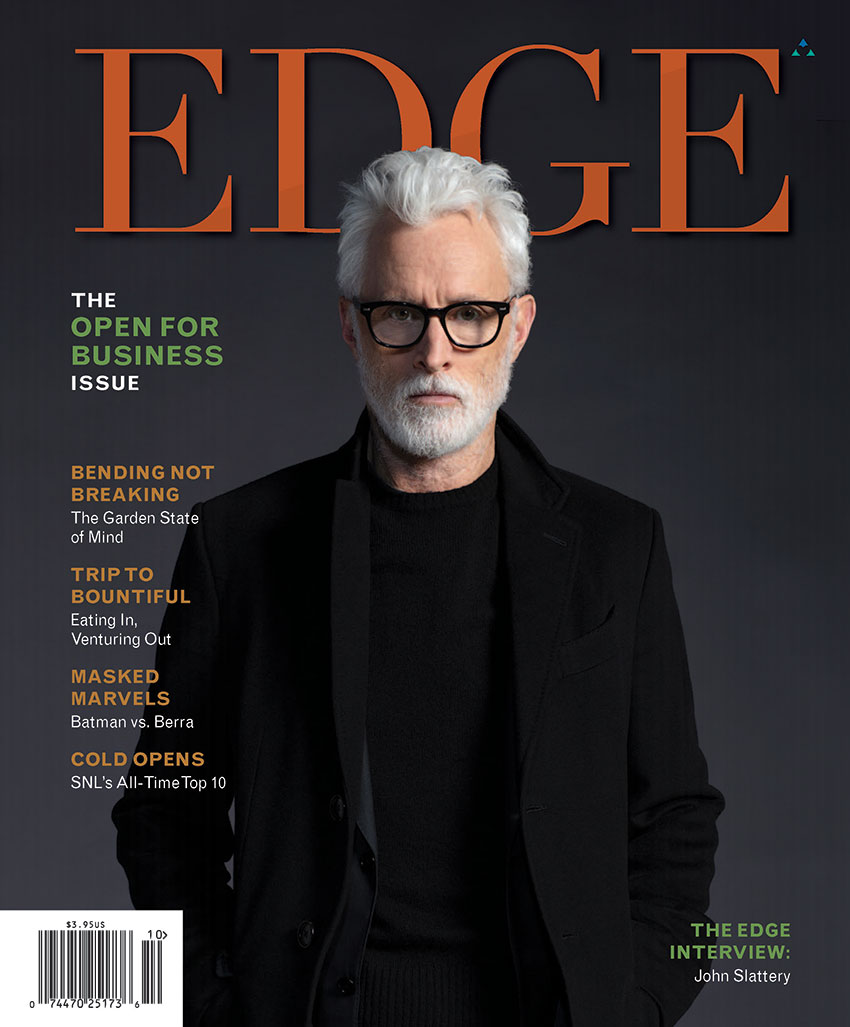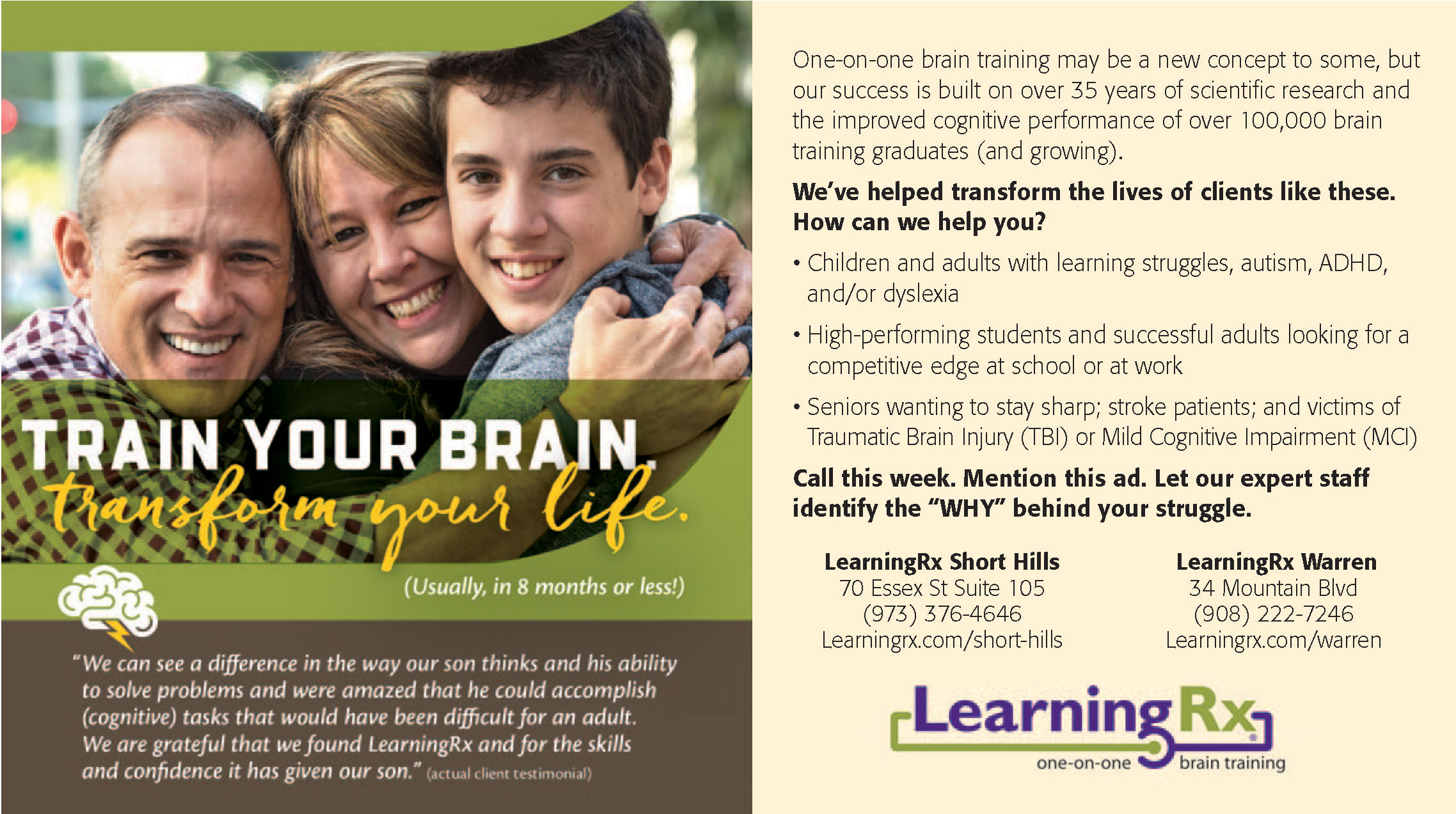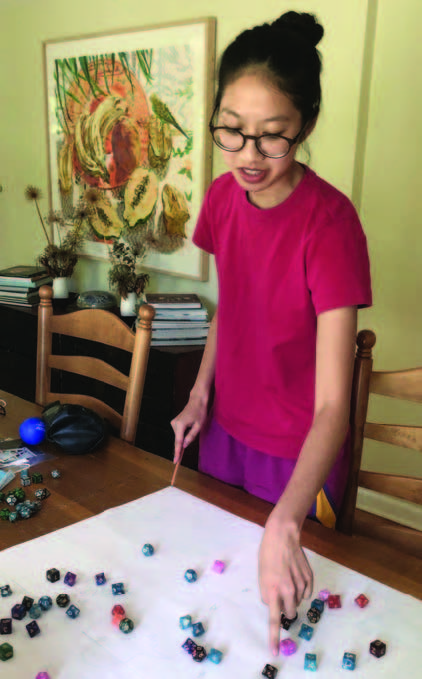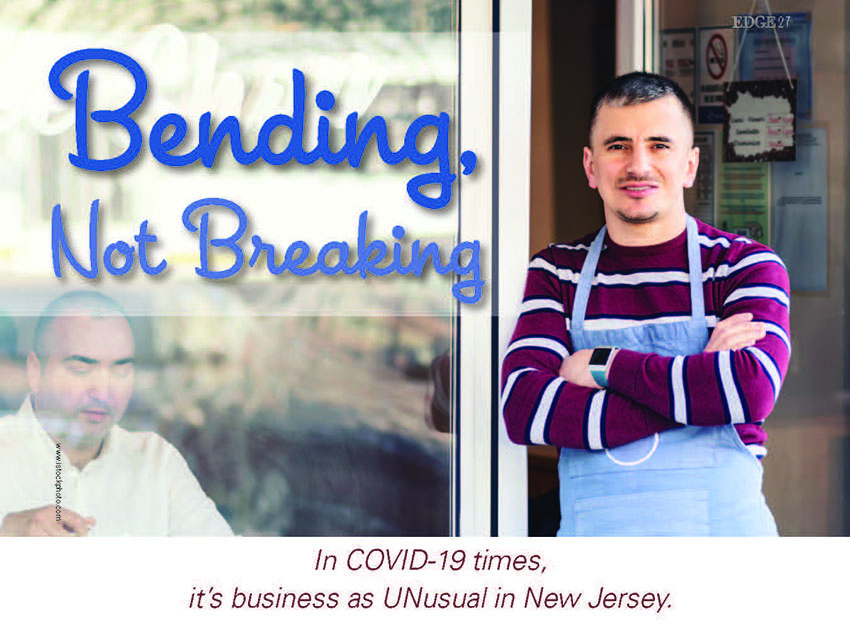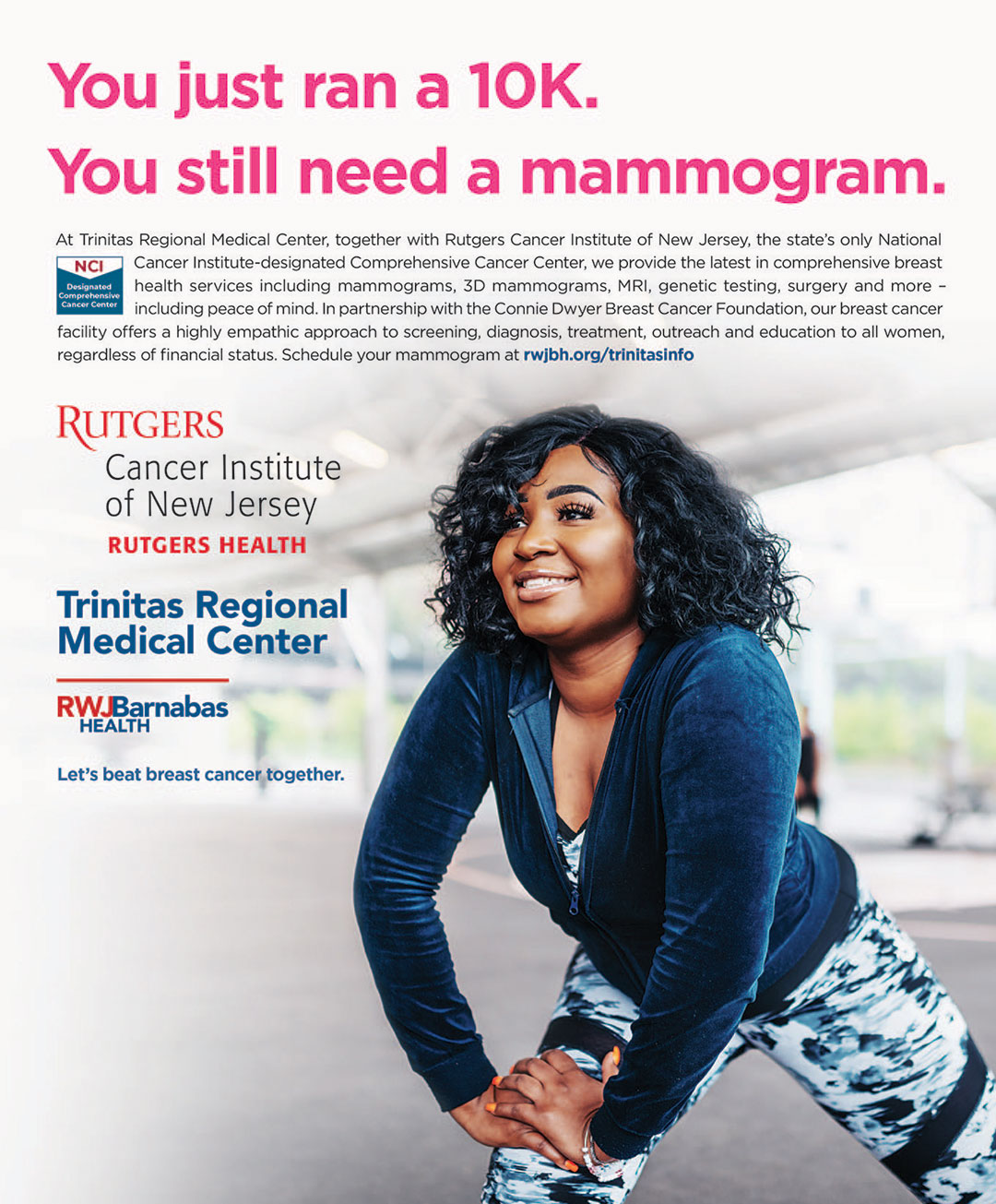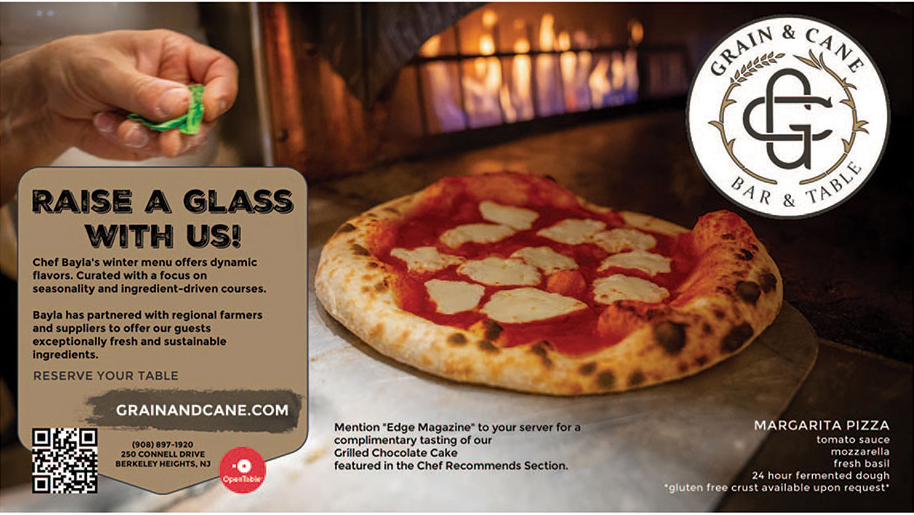
Photo by WABC Radio
In 1961, a twenty-something DJ with a warm but booming voice hit the airwaves in New York for WABC and Rock & Roll was never quite the same again. Bruce Morrow, aka Cousin Brucie, played it all during his evening show, which could be heard for hundreds of miles up and down the East Coast. Like most radio jocks, Morrow looked for a side gig to boost his popularity. He began hosting weekend music shows across the river at Palisades Amusement Park and those raucous concerts drew teenagers from New Jersey, New York and Connecticut like moths to a flame. With a dozen or more acts sharing the stage, the Palisades Park shows soon became a high-powered launching pad for new records, in turn launching Morrow into the industry stratosphere. And there he remains. More than five decades later, thanks to the enduring quality of that era’s music and the loyalty and love of all those screaming baby boomers, he has returned to WABC to spin records on Saturday nights.
EDGE editor Mark Stewart, whose parents refused to take him to those legendary shows on the cliffs of Fort Lee, finally got his chance to connect with Cousin Brucie.
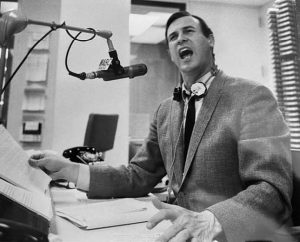
WABC Radio
EDGE: Music fans around the country, myself included, know you from your radio career, from WABC to NBC to CBS to Sirius XM and now back to WABC. But a lot of people in New Jersey remember the decade or so you put on those epic weekend Cousin Brucie Rock & Roll shows in the music pavilion at Palisades Amusement Park. Where does that fit into the big picture?
BM: If you asked me what the most important part of my life is, there are two things I would mention: Palisades Amusement Park and introducing the Beatles at Shea Stadium, as well as my involvement with them. But Palisades Park would be number one. There is a great line about that: Here is where we grew. Here is where we got older. Here is where we learned. It was the happiest time of my life, a time of physically being with my audience. For just about a decade, I hosted and produced the shows and had a wonderful time. It’s really where I discovered what I was going to do for the rest of my life on the air. It was those beautiful live contacts on those beautiful, sometimes rainy Saturdays where I developed Cousin Brucie.
EDGE: You brought in some huge names there. What was your level of involvement behind the scenes?
BM: I booked all the acts. I would make a call and, fortunately for me and for Palisades Park, the artists would perform gratis to promote their music. If you made an appearance at Palisades Park, you really were going to sell a lot of records. They knew darn well that, if they appeared with Cousin Brucie, we were going to have a good time, and a profitable time.
EDGE: A lot of DJs in your era had side gigs to survive. This was something more, though.
BM: Absolutely. The love of that audience sitting there in that wonderful outdoor “auditorium” was amazing, it was immense, because we were so close to each other—I was always in the audience. And it never ceased. Every week I would have 10, sometimes 15, acts on that stage, including some of the biggest acts in the country. And remember, they lip-synched the music. That was a very important part of the story. In the 1960s, that was okay. Irving Rosenthal, the owner, did not want to spend a lot of money, so we couldn’t afford bands.
EDGE: And that came off without a hitch?
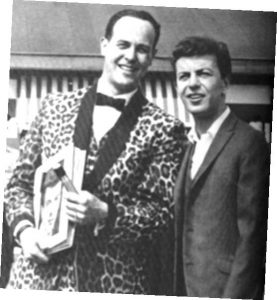
Bruce Morrow
BM: The equipment was not the latest, shall we say. The turntable was in a very little booth and the stylus, well, you might as well have had a screwdriver on the record. So every once in a while, records would skip. In 1962, it happened to Tony Bennett and he got pretty upset. I don’t blame him. We broadcasted a lot of our shows live—thank god this wasn’t one of them. Columbia had just come out with his album I Left My Heart In San Francisco and they knew it would ensure quite a number of sales for Tony to perform at the park. So the record starts and he’s lip-synching: I left my heart…in…San Francisco-cisco-cisco-cisco-cisco-cisco-cisco. He was very upset. We finally got him back on and he finished the song and he left in a huff. To this day he has not forgiven me. Four or five years ago he was visiting Sirius XM where I had a show and he left me a note: “Cousin Brucie, do me a favor and don’t play my records anymore.” He was just teasing me, but he never forgot. I never forgot, either. I was terribly embarrassed. It happened a few times, but not often. With most people, they would just go along with it until we fixed it. The audience would applaud and laugh. They knew we were lip-synching.
EDGE: Were there little-known performers who blew you and the audience away when they appeared?
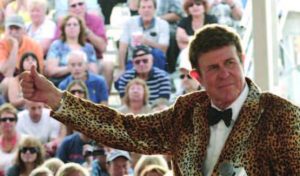
Cousin Brucie Friendship Page
BM: Oh, there were so many. Every time a record came out that I liked, I would contact the record company and we’d put them on the stage. One I remember right off the bat was a fellow named Curtis Lee. Like so many performers, Curtis actually introduced his record “Pretty Little Angel Eyes” for the first time on the stage at Palisades Park. It was a good, rocking song. He was introduced by his mentor, Ray Peterson, who sang “Tell Laura I Love Her” and so many other great songs. Ray came out with me on the stage and introduced Curtis Lee as his “protégé” and he performed his song for the New Jersey, New York, Connecticut audience. And it did very well. The record did not skip that day—if it had skipped that would have been terrible because Curtis had no experience. He was scared stiff!
EDGE: Does one moment stand out from your years at Palisades Amusement Park?
BM: We had a young lady from Tenafly, about 15 years old named Lesley Gore. She became a very dear friend. We lost her a few years ago, way too young, but her music survives. Lesley came out on stage, she was so tiny and so nervous—this was one of her first times in front of a major audience. She was standing next to me—I was wearing my leopard-skin suit—and she looked up and I could see she was upset, in some kind of pain. That stage, which wasn’t exactly up to date, had some cracks in it. Poor Lesley had caught the heel of her right shoe in one of the cracks. She whispered to me, “Cousin, my shoe is stuck. I can’t move.” I kneeled down, put the microphone on the stage, slipped her foot out of the shoe and pried the heel out of the crack in the board—and put her shoe back on like a princess. Then she went out and did “It’s My Party” and was phenomenal. And she did cry…but because her shoe was stuck.
EDGE: The return to WABC, which is now a talk station, with your Saturday Night Rock & Roll Party has created a huge amount of buzz. Were you expecting this “reconnection” to have this kind of effect?
BM: I knew it would be pretty exciting but I had no idea it would be like this.
EDGE: So I have to ask, when you see fans in their 60s or 70s, is that screaming teenager still in there somewhere?
BM: Oh, they’re still in there. The emotion and excitement and affection is there no matter how old they are. They want a hug—which unfortunately we can’t do right now. I feel the love and the affinity and the connection. See, connection is a good word here. I was, and am, a connection to a better time in life. Oh, we had a lot of problems in those days, but I represent a bridge that is very important today, because everybody wants to go back a little bit, they want to escape this nightmare we’re going through, nightmares that we’ve been going through, for a couple of decades or so. So here is this guy who’s a connection to a good time through something called music. Shakespeare wrote in Twelfth Night, “If music be the food of love, play on.” Well, that’s what I’ve been serving up: energy, spirit and mutual love and respect. I don’t care where you’re from, we have this one thing in common and it’s music—the music of the 50s, 60s and 70s. It’s an amazing common bond.
Editor’s Note: Cousin Brucie’s Saturday Night Rock & Roll Party began airing on WABC in September from 6:00 to 9:00 p.m. and can be heard at wabcradio.com and can be streamed on the WABC app. He looks forward to restarting his live oldies concerts at PNC Arts Center in Holmdel once public gatherings are safe for his fans.
Fresh out of ways to stay busy at home this winter? These products will get you thinking outside of the box.
 Growth Spurt
Growth Spurt
If you live in New Jersey, finding farmstand-fresh garden herbs and vegetables during the winter months can be an exercise in futility. And a decent tomato? Soul crushing. Which is really all the convincing you should need to check out one of the new artificially intelligent indoor produce-growing devices. We like the Smart Garden 9 by Click & Grow, a company run out of San Francisco (with a second office in Estonia—we don’t know why). It features a professional-caliber grow light and nano-material “smart soil” that releases nutrients, oxygen and water to as many as nine different plants. The product also comes with little biodomes to fast-track sprouting.
 Image Conscious
Image Conscious
Your phone is filled with great photos. You’ve got boxes of old-school color prints somewhere and, oh yeah, all those albums. Hey, don’t forget the family archives of black-and-white ancestors. What to do with all of these pictures? A number of companies will make blankets, throws and other large decorative products featuring a collage of your most cherished, unforgettable images. Collage.com is a good starting point. It has actually become a competitive business, which is good for you. Pay attention to the quality of fabric you’re ordering—that makes a difference in terms of usability and durability. Done well, these blankets could just be the hit of the holiday gift-giving season. Done poorly, they will embarrass your sensitive teenager for years. In other words, you win either way!
 Scrap Collector
Scrap Collector
Every home, it seems, has that one closet shelf piled high with material scraps and random textiles from the ghosts of projects past, present and future. Well, could there be a better time than now to pull them together into a killer quilt? Coronavirus has pretty much ruled out the quilting-bee option, which means you’re on your own. Before you begin, consider a sewing machine built with quilting specifially in mind. There are a lot of choices at a wide range of price points, starting in the hundreds and creeping into the thousands. One of the more popular and affordable machines is Brother’s HC1850. It comes pre-programmed with 185 different stitching patterns and a wide table for quilting, plus—and this is important—free access to an actual human to answer quilting questions for as long as you own it.
 Be Still My Heart
Be Still My Heart
Tempting as it may be, day-drinking is never a good idea. But making your own booze anytime is now an option with one of the new-fangled high-tech home stills that are on the market. We’re talking moonshine, of course, a product that has found its way out of the hills and into the suburbs in recent years as a liquor of choice. Among the many food-grade home “hobbyist“ kits on the market is the Stainless Steel Stovetop Still made by How to Moonshine, a Canadian company doing brisk business in the United States. It’s a five-gallon, food-grade piece of equipment that can produce three liters in a couple of hours, and works on a gas burner, induction cooktop or electric hotplate. Yes, it’ll make your kitchen look a little like Walter White’s cook room, but creating your very own batch of firewater to your own particular taste sounds like a lot of fun.
 Tunnel Vision
Tunnel Vision
Are you one of those Why should I do all the work people? Perhaps one of Wall Colony’s  Woodframe Ant Farms is calling your name. These relentless tunnelers create an ever-changing natural landscape and are a daily reminder of what can be accomplished when we all work together. The frames come first—in walnut, oak or cherry—and the ant colony follows a few days later after you’ve done a simple set up.
Woodframe Ant Farms is calling your name. These relentless tunnelers create an ever-changing natural landscape and are a daily reminder of what can be accomplished when we all work together. The frames come first—in walnut, oak or cherry—and the ant colony follows a few days later after you’ve done a simple set up.

Where’s the Beef?
Have you noticed that the quality of meat at your local grocer has improved over these last few months? Where “choice” was often the best choice, now “prime” cuts are showing up—often at choice prices. With so many restaurants either shuttered or working at low capacity, meat purveyors have had to forge new relationships with supermarkets. Who knows how long this will last? One way to take advantage of this fortuitous glitch in the supply chain is to use these prime cuts to make delicious jerky. To do that, you’ll need a machine. Some are big, bulky and expensive. But others are not. Unless you plan on opening a side hustle, then the Nesco Snackmaker Pro will do just fine. It’s technically a dehydrator, which means you can use it for fruits and vegetables if you like, but jerky aficionados give it solid reviews. You’d be surprised how many closet jerky lovers there are out there, and with retail prices soaring for even the most modest portions, you may want to increase production once friends and family find out what you’re up to. This model is actually expandable, so no problem there.
EDGE takes you inside the area’s most creative kitchens.
 Grain & Cane Bar and Table • Maine Lobster Benedict
Grain & Cane Bar and Table • Maine Lobster Benedict
250 Connell Drive • BERKELEY HEIGHTS
(908) 897-1920 • grainandcane.com
Butter poached lobster, cage-free poached eggs and bernaise sauce. The flavors combine to create a beautifully silky dish that will be a weekend brunch favorite.
 The Thirsty Turtle • Pork Tenderloin Special
The Thirsty Turtle • Pork Tenderloin Special
1-7 South Avenue W. • CRANFORD
(908) 324-4140 • thirstyturtle.com
Our food specials amaze! I work tirelessly to bring you the best weekly meat, fish and pasta specials. Follow us on social media to get all of the most current updates!
— Chef Rich Crisonio
 The Thirsty Turtle • Brownie Sundae
The Thirsty Turtle • Brownie Sundae
186 Columbia Turnpike • FLORHAM PARK
(973) 845-6300 • thirstyturtle.com
Check out our awesome desserts brought to you by our committed staff. The variety amazes as does the taste!
— Chef Dennis Peralta

The Famished Frog • Mango Guac
18 Washington Street • MORRISTOWN (973) 540-9601 • famishedfrog.com
Our refreshing Mango Guac is sure to bring the taste of the Southwest to Morristown.
— Chef Ken Raymond
 Arirang Hibachi Steakhouse • Pork Belly Bao Buns
Arirang Hibachi Steakhouse • Pork Belly Bao Buns
1230 Route 22 West • MOUNTAINSIDE
(908) 518-9733 • partyonthegrill.com
Tender pork belly, hoisin sauce and pickled cucumber served on a Chinese bun.
 LongHorn Steakhouse • Outlaw Ribeye
LongHorn Steakhouse • Outlaw Ribeye
272 Route 22 West • SPRINGFIELD
(973) 315-2049 • longhornsteakhouse.com
Join us for our “speedy affordable lunches” or dinner. We suggest you try our fresh, never frozen, 18 oz. bone-in Outlaw Ribeye—featuring juicy marbling that is perfectly seasoned and fire-grilled by our expert Grill Masters. Make sure to also try our amazing chicken and seafood dishes, as well.
— Anthony Levy, Managing Partner
 Ursino Steakhouse & Tavern • House Carved 16oz New York Strip Steak
Ursino Steakhouse & Tavern • House Carved 16oz New York Strip Steak
1075 Morris Avenue • UNION
(908) 977-9699 • ursinosteakhouse.com
Be it a sizzling filet in the steakhouse or our signature burger in the tavern upstairs, Ursino is sure to please the most selective palates. Our carefully composed menus feature fresh, seasonal ingredients and reflect the passion we put into each and every meal we serve.
Support Our Chefs!
The restaurants featured in this section are open for business and are serving customers in compliance with state regulations. Many have created special menus ideal for take-out, delivery or socially distant dining, so we encourage you to visit them online.
Do you have a story about a favorite restaurant going the extra mile during the pandemic? Post it on our Facebook page and we’ll make sure to share it with our readers!
THIS IS WHY TRINITAS IS IN OUR WILLS!
“Without Trinitas, many would suffer agonizing pain and misery; many would indeed lose their ability to make a living and provide for their families.” Grant Hobson explained, “A large city like Elizabeth and its surrounding areas need Trinitas to provide valuable healthcare for their diverse population. Trinitas provides quality healthcare for all regardless of color, creed, religion or the ability to pay for health insurance. I truly believe giving to people in need is next to Godliness.”
“I lost my father when I was 16.” Grant, now 81 years old, still thinks of his father often. “While he lived, my father was a kind and gen-erous man who cared deeply for those less fortunate. Additionally, my father-in-law was a well-known surgeon with a close affiliation to Trinitas. Through him I started to learn about the importance of the hospital to the community and I gained a similar respect for him as I had for my father. Knowing first-hand the kindness and commitment that is shown to patients at Trinitas, the action of giving to the Medical Center resonates very strongly with me. It is no surprise that my wife, who grew up in Elizabeth, shares my sentiments and agrees that leaving Trinitas in our wills gives us the satisfaction of knowing that our fathers’ traditions will be honored in perpetuity. This brings us a deep sense of contentment.”
“My wife and I have no heirs so why not leave our legacy to an organization that we know will provide an invaluable ongoing benefit to mankind? Rather than let the government, whom we do not know, take charge of our estate!”, Grant said with a chuckle. “I like knowing that when I am gone, the money that my wife and I earned over a lifetime of hard work will be put to good use for mankind by Trinitas!”
God first, the other fellow second, myself last is a motto that Grant discovered as a child. It struck him profoundly and he has tried to live by it ever since. He strongly encourages others as well to inquire into ways to leave Trinitas in their will. “For by giving to Trinitas,” he says, “you are giving to the other fellow and thereby ultimately giving to God.”
Grant Hobson is a longtime volunteer at the Trinitas Comprehensive Cancer Center and a trustee on the Trinitas Health Foundation Board. Grant and his wife have left Trinitas in their wills.
To make a legacy gift or if you have any questions, please contact Nadine Brechner or Bidisa Rai at 908-994-8249 or by email at NBrechner@Trinitas.org or BRai@Trinitas.
 BACK TO SCHOOL
BACK TO SCHOOL
Back to school time is here! Friend of Trinitas Lucila Roberts donated boxes and boxes of school supplies for our pediatric behavioral health patients. We thank Lucila for giving our patients all the tools and supplies they need to be successful in the classroom this year! Receiving the donation are Program Directors Mike and Andy.
 2020 GOLF CLASSIC RAISES $213K
2020 GOLF CLASSIC RAISES $213K
More than 140 golfers gathered at Fiddler’s Elbow Country Club in Bedminster for the annual Trinitas Golf Classic. While things looked a little different this year, the socially distanced event was complete with golf contests, a raffle drawing, golfer prizes and great company. While our golfers were out enjoying the gorgeous weather, 10 spa guests had a day of pampering at Skin Deep Salon and Spa in New Providence. Above: Tom Frayne and Donald Van Biert of County Glass & Metal Installers with Trinitas President & CEO Gary Horan and VP of Marketing and EDGE Publisher Doug Harris. For more information on the 2021 event contact Kim Boyer at kboyer@trinitas.org or (908) 994-8249.

One family’s pandemic response.
My kids, a boy and a girl, are grown and I thought I was way beyond having another child. Yet in the midst of the first outbreak of the COVID-19 virus, on March 15th, we welcomed another daughter to our family. It was not an ominous, painful Caesarian delivery to beware of on the Ides of March, but the fortuitous and joyful arrival of our third child, Cindy. Really, I’m so over diapers and bottles, and, happily, so is Cindy—after all, she was delivered to our home at a full-grown mature-ish 26 years old.
Cindy’s arrival was unexpected. As the pandemic raged in New York City, our daughter Charlotte had debated for over a week whether to leave her apartment in Astoria, Queens. On a whim, she sent out a blanket invitation to her New York-based friends asking if anyone wanted to shelter in place at our house in New Jersey. Cindy, a former college classmate living in Brooklyn, with 24 hours’ notice, filled a book bag with clothes, grabbed her laptop and joined Charlotte on a turbulent ferry ride from Pier 17 to New Jersey and settled in our once empty nest.
My husband and I didn’t properly welcome them, because we were “vacationing” for two weeks in Florida when the virus hit. Restful and relaxing, it was not. As Vero Beach restaurants closed like dominos, our stress level rose. We cancelled our plane reservations, packed up our shorts, swimsuits and sandals and headed north in our rental car five days earlier than expected. We spent two nights with relatives near Charleston and then stayed another night in Richmond at the huge, cavernous Jefferson Hotel, where we well may have been the only paying guests and certainly were outnumbered by the staff. For two weeks after we finally arrived home, our kids and Cindy social distanced from us—nothing new about that, only now they had a good excuse.
I was curious how we, as a family that once lived separately, would acclimatize to being two generations of adults, no less with an additional Millennial in the mix.
Cindy was ensconced in the guest bedroom and it was a huge relief that we could tell from the beginning that she easily was more like a family member than a guest. We carted up a small wooden table that served as her telecommuting desk and made sure she knew she was welcome to stay through the months ahead. Our main concern was for everyone to be healthy and safe.
An extra person in one’s home could spell disharmony, stress and strife. To her credit, Cindy fit in seamlessly: a friend, confidant and walking partner to our daughter; the only one who could discuss Dungeons & Dragons and video games knowledgeably with our son; and a little buddy to me as we shared similar sensibilities and sense of humor.
Cindy was socially astute as she quickly read my husband’s amusing, if naughty, trickery, cleverly dodging questions that really were ways to ensnare the unwary. When his eyes narrowed in mock earnestness and he queried, “Who’s the most chill person in the family?” or “Who is or was the most badass person at the table?” or “Who is the shining star of the family?”, she would foil his ploy and answer with: “It’s a trap, right?” It’s not easy to fit into quirky humor, but Cindy did and even added her own brand to the mix.
So that’s how we became a family of five, all with our own careers, habits and social groups. Every day, we met for early breakfast, and then we disappeared into our separate Zoom realms within our own bedroom cyber-offices where we dealt with educational funding, Garden Club challenges, asset management and cultural exchanges. (As well as the occasional dog-walking gig thrown into the mix.)
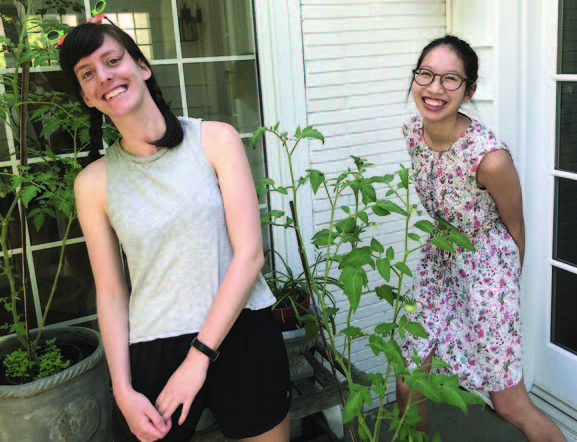 My husband and I are not newcomers to taking in friends in need. In fact, after Super Storm Sandy, we invited a family of five—three boys aged one to six and their parents—whose home had been flooded and was uninhabitable for two months. We and they had a blast together living like a cross-generational dorm.
My husband and I are not newcomers to taking in friends in need. In fact, after Super Storm Sandy, we invited a family of five—three boys aged one to six and their parents—whose home had been flooded and was uninhabitable for two months. We and they had a blast together living like a cross-generational dorm.
Our new family of five established a routine as the coronavirus lockdown wore on. Wednesday, for example, was family game night, where Cindy taught us—sort of—the finer points of poker and video dancing and our son set up amusing online group games. Our leisure pastimes became a cross-section of cyber activities and capers. Saturday was Zoom craft night for the girls and Zoom cocktails for us. And every non-working moment, our son was gaming virtually with former college friends. Saturday morning, Sunday and Tuesday nights, Cindy was telelearning French, Chinese and Japanese, respectively.
Most importantly, Sunday was clean-your-bathroom day.
Efforts to create positive experiences spilled over to internet activities. Charlotte’s co-workers hosted an international Zoom Karaoke night that engaged Cindy and me—although I am challenged tonally and ignorant of the hits of the last 20 years. And then there were countless girls’ movie nights watching a cache of chick-flicks through the ages from The Women to the latest release of Little Women and My Man Godfrey. Who could tire of a diet of binge-watching comforting Jane Austin films and their offshoots like Clueless for Emma and Bridget Jones’ Diary for Pride and Prejudice? Thank goodness for WIFI and our unlimited usage plan
I recognize that it’s not easy to move into a family with a quarter-century of established traditions, habits and idiosyncrasies. Yet Cindy adapted to all, incorporating routines and rites, adopting family traditions and adeptly demonstrating that she too shared in (or at least accepted) many of our quirks. She further endeared herself by embracing our interests
My home activities tend to revolve around writing, cooking and gardening, as well as Garden Club. Our garden, the culmination of 26 years of planting, dividing, pruning and propagating, was particularly well-tended during Cindy’s months here thanks to our son being furloughed for a couple of months, and our hiring him to weed, mulch and plant. It became a subject of fascination for Cindy. While the pandemic has been frightful and constricting, the delayed Spring brought unexpected joys in the garden. It made me happy that Cindy seemed impressed and charmed as the seasons changed and blossomed in our garden; the years of planting perennials had created a magical botanical experience for her. The evolution from camellias and daffodils to tree peonies and lilacs to herbaceous peonies and hybrid tea roses to summer’s hydrangeas, daisies and phlox were highlighted by the delight and wonder Cindy found in our garden. The sudden enlargement of our family, as well as concern for food safety during the pandemic, inspired me to propagate edibles in window boxes, normally reserved for wildly colored ornamental flowers. Cindy watched as I harvested lettuce, radishes, chervil and micro-basil—all grown from seed among pansies and nasturtiums, also edible flowers. You may wonder why I didn’t plant a full-blown “victory garden”…the answer is a four-letter word: DEER.
Wildlife presented diverting attraction, particularly hummingbirds—the kids found a nest the size of a demitasse cup. Also aggressive groundhogs, perhaps emblematic of the monotony of our COVID existence, ventured uncomfortably near our home. Cindy, in her fearless fascination and enthusiasm of the new, chased them away in energetic pursuit
When it rained, we occupied ourselves with 1,000-piece jigsaw puzzles, family Scrabble, and backgammon. Much of our insular pandemic life revolved around food. While none of us gained the legendary COVID-19 pounds, I cooked up a storm. Our kids, string beans all, ate like sumo wrestlers. A huge vat of Bolognese sauce disappeared in two sittings. An iced chocolate zucchini cake for 16 vanished in two days with us ploughing through even the portion reserved for a godparent. And no one was more appreciative than Cindy. Every morning, be it waffles or oatmeal or smoothies, I’d hear her appreciative Oooooh. And Cindy always arrived first for lunch—often grilled cheese and homemade soup—and was my best customer for dinner. It’s easier to cook when everything you concoct is greedily inhaled. Nothing like a thankful public to spur on the home chef.
I cooked during the week and my husband and kids cooked during the weekend and were specifically not allowed to ask me about recipes. Food, the source of survival, variety and taste thrill, was a gathering point as we all emerged from our bedroom offices to eat and savor, share work complaints and challenges and give positive support during the trials of the pandemic.
During this anxious, dismal time of sickness, contagion and death, many have felt isolated, frustrated, and at loose ends. So much has been lost, even if temporarily. Gone are exotic travel to distant lands or even to two states over. Visits to museums, the cinema and friends’ homes are temporarily obsolete. And our naturally social beings are being constricted. Our world has gotten smaller and we are living, communicating, working and amusing ourselves through home electronics. The days are monotonous, one running into the next, with little change. Yet we hold on to a deep gratitude that we are alive and well.
After four months, Cindy had become part of our family fabric. She was a bright spot, always upbeat, with a ready and, dare I say, infectious smile. We all felt blessed to have her in our lives and I dreaded the day she would leave. I saw Cindy as a buffer—a friendly shock absorber between potential sibling conflict and a humorous shield between the generations, safeguarding family harmony in close quarters.
Did I neglect to mention that Cindy’s mother owns a hair salon in Wisconsin and her mother trained and entrusted her to color her own gray locks? Due to social distancing and state-mandated closure of hair salons, many friends have had to embrace the truth of the aging process. While I’m pretty low maintenance—no Botox, fillers, nip or tuck—thanks to Cindy, I can continue the pretense of forever-young hair. So as I started to observe during Zoom meetings and parties that friends and colleagues’ coifs were evolving into various iterations of the skunk family, my own tresses remained deceptively brown. I love my local salon stylist and wonderful colorist Coleen, but for endless months, that was not an option. Cindy and a regular shipment on “auto-order” of Madison Reed’s Veneto Light Brown hair dye kept me looking like my old self—but not that old.
Cindy and I also are crossword enthusiasts, and she would email me her Sunday New York Times—which she received, for an extra fee, that I have been unwilling to pay for but happy to print out hers. Cindy is a joy. She is fun, smart and engageable.
It was a super sad day in mid-July when, after dinner, Cindy gulped and announced that she would be leaving our house to pack up her room in Brooklyn and drive with a roommate back to Wisconsin. While we knew the day would come, we choked out a Say it ain’t so. I fretted with Cindy’s impending departure: How to plan for meals for four rather than five? What or who would serve as glue for our vastly different offspring? How would our kids view us without the humor that Cindy brought to our family? (Don’t tell me, we’re still annoying.) The morning arrived with Charlotte loading her car to move out of Astoria and then drop off Cindy. I handed Cindy a bag filled with an assortment of her favorite foods—Heritage Flakes, smoked oysters in oil, chipotle aioli—and hugged her goodbye.
Cindy had been an important part of our family’s emotional survival during the first four months of COVID-19. She was a sweet, friendly, sunny cure for the isolation and strangeness of the pandemic and we dreaded her inevitable exit. We anxiously speculated how were we going to endure what might be another year or so without someone who had become such an integral and positive member or our family. But it’s a funny thing, that life goes on. We are a family that has enough love to open our house and hearts to Cindy and we are happy she is back with her mother and on to a new adventure.
We definitely miss Cindy and I think we are a better foursome thanks to her. But my heart doesn’t ache the way I worried it would. We stay in touch; she will always be a part of us. In case I forget, every Sunday—or sometimes Monday—an email arrives from Cindy to challenge and engage me with The New York Times Sunday crossword.
Oh, and in case you’re wondering, Charlotte became my expert new colorist. Before departing to the wilds of Wisconsin, Cindy taught her how.
In COVID-19 times, it’s business as UNusual in New Jersey.
By Christine Gibbs
At 1,200 people per square mile, New Jersey is America’s most densely populated state. We paid the price for that honor in disrupted and lost lives when COVID-19 struck. New Jersey’s 800,000 businesses, which employed nearly a quarter of its 8.9 million residents when the pandemic arrived, felt this pain deeply, too. The numbers won’t be pretty when it is all said and done, but the state’s economy is resilient and our people are tenacious and talented. Indeed, amid the crushing reports of store closings, bankruptcy proceedings, and other bad news, there seems to be a new story every day about innovative thinking or inspired action that has enabled a business here to survive and even thrive in the face of the most daunting conditions.
Under normal circumstances, it would be difficult to draw a through-line connecting a noodle shop, a church, a college, a dog groomer, a barbecue rub, and a brewery. But here we are in the new normal, and these are some of the folks who refused to let the virus stand in their way.

Photo courtesy of Ani Ramen
USING HIS NOODLE
A few years back, EDGE ran a glowing review of Ani Ramen, an authentic Japanese noodle house that opened in Montclair and added a second location in Jersey City in 2017. When the coronavirus arrived in March, founder Luck Sarabhayavanija was up to five restaurants with four more on the drawing board. When dine-in privileges were revoked, he quickly switched gears in order to support the staff and the greater community. Luck recast Ani as a nonprofit “pop-up” to provide for the hungry, the needy, and first responders. The result: Rock City Pizza Company and Bang Bang Chicken shops, from which customers could order Detroit-style pizza or Chinese-style rotisserie chicken…and get another one at half price to donate. These new ventures were an immediate success, but demands from patrons of Ani’s original ramen chain prompted the opening of Ani Express, a takeout location featuring some of the company’s top-selling bowls. Customers picked up easy-to-assemble kits (to avoid cold or soggy noodles) to bring home, reheat, and Slurp-Sip-Repeat—Ani’s recommended technique for fully embracing the Japanese noodle experience. Ani’s noodles are alive and well thanks to its unique, outside-the-box response to COVID-19. The non-profit is humming along and Luck is already thinking ahead to reopening his original five restaurants and resurrecting his tabled plans for four more when the pandemic passes.

Photo courtesy of Carton Brewing Company
BEER NECESSITIES
“We are just keeping the lights on, surviving not thriving…in this business, you have to be nimble, you have to hustle, you can’t waste time just believing, you have to start thinking.” So says Augie Carton of the  Carton Brewing Company, one of the top craft beer producers in the state when the pandemic struck. With bars and restaurants shuttered, he and cousin Chris Carton immediately started thinking local. They ramped up production of a beer named 077XX—those three numbers start the zip codes of most Jersey Shore towns—which they had already been developing based on a “flavor commonality” that had emerged during extensive market research. Carton Brewing focused on what would appeal to the most common denominator among local beer drinkers—so no, not for the careful consideration of an educated palate (as with their other products) but for consumption by the “most drinkers possible.” Devotees old and new have been heading to the company’s new facility in Atlantic Highlands to fill their personal growlers and crowlers with their new flagship beer, the aforementioned 077XX, ever since.
Carton Brewing Company, one of the top craft beer producers in the state when the pandemic struck. With bars and restaurants shuttered, he and cousin Chris Carton immediately started thinking local. They ramped up production of a beer named 077XX—those three numbers start the zip codes of most Jersey Shore towns—which they had already been developing based on a “flavor commonality” that had emerged during extensive market research. Carton Brewing focused on what would appeal to the most common denominator among local beer drinkers—so no, not for the careful consideration of an educated palate (as with their other products) but for consumption by the “most drinkers possible.” Devotees old and new have been heading to the company’s new facility in Atlantic Highlands to fill their personal growlers and crowlers with their new flagship beer, the aforementioned 077XX, ever since.

Photo courtesy of Liquid Church
LIQUID GOLD
Houses of worship and other places of spiritual gathering have had a particularly hard go of it during the pandemic. The very qualities that bind their adherents—community, fellowship, and physical proximity— threatened to unravel once everyone was ordered to keep their distance and shelter in place. Among the numerous examples of resilience, sacrifice and clever work-arounds is one church that seemingly has gone viral thanks to the virus. Liquid Church, headquartered in Parsippany, is not your typical church (you probably guessed that from the name). Its goal is to “provide a religious experience that is the most refreshing opportunity on the planet to quench the spiritual thirst for a religious grounding, especially in these trying times,” according to lead pastor Tim Lucas. The church opened its doors in 2007 and also offered online services through CHOP, the Church Online Platform. When the pandemic arrived in New Jersey, Pastor Tim shut the doors in all three in-person worship locations and concentrated on Facebook and YouTube. Within months, the congregation grew from a robust 5,500 to a digital audience of more than 12,000. Liquid Photo courtesy of Liquid Church Church was also able to turn its Parsippany property into a makeshift warehouse, distributing “Boxes of Hope” to tens of thousands of residents in the surrounding towns. Unsure of when and how a reopening will be possible, Lucas focused on planning “re-gathering” efforts over the summer, including a safe-distancing “Liquid On the Lawn” BYOB (Bring Your Own Bible) event that prompted some people to assume, he laughingly admits, “we were either a cult or a drinking fraternity.”

Photo courtesy of Stevens Venture Center
NOTHING VENTURED
“Startups and the entrepreneurs behind them are like indestructible weeds that will survive and grow despite all obstacles, even COVID-19.” Strong words from David Zimmerman of the Stevens Venture Center (SVC) at the Stevens Institute of Technology in Hoboken. To be sure, in chaos and uncertainty, opportunity often flourishes. Zimmerman, the Director of Technology Commercialization at SVC, acknowledges that start-ups are never easy, even under the most favorable economic and social conditions. Add the overwhelming pressure of having to launch a fledgling venture in the throes of a pandemic and that only adds to the uncertainty. That is why the Venture Center has been a beacon of hope, a “safe house and sanctuary” for preserving and elevating the spirit of community-conscious innovators and entrepreneurs. “We are here to help daring innovators commercialize their vision into something spectacular,” he says. The response to the pandemic under Zimmerman involves the popular Hackathon, a marathon of budding tech superstars and promising mentors and sponsors, who convene in teams to define a specific problem and then sprint to find a breakthrough that has the potential to become a commercial reality. It’s now known (at least temporarily) as the COVID Health Hackathon.

Photo courtesy of Stevens Venture Center
DOGGED PERSISTENCE
You know who made out like bandits when we were all told to stay home? Dogs. Suddenly and without warning, dog owners were home all day, talking to their pets (because who else was there?) and walking them two or three or four times between sunup and sundown. It was a great time for Canine-Americans. Not so great, however, for dog groomers and other hands-on pet-related businesses. When the world began to reopen, so did my local dog salon,  Shampoochies. Owner Sherri Amador was faced with a steady stream of horrendous home grooming disasters and a large number of dogs that were channeling the fear and stress of their stay-at-home owners. In addition to minimum-contact drop-off and pickup practices, her groomers began offering soothing massages to stressed-out pups and added a dog training option as another creative add-on to make up for the loss of vital revenue from the sale of treats, leashes, and other impulse items. Sherri confirmed the fact that her staff has upped the ante on TLC—both for dogs and their owners—and has corrected a number of strange grooming attempts by her clients. These tweaks and their great results helped Sherri recapture 70% of her business, which has enabled her to keep three full-time groomers busy. And tips are up from grateful customers, she adds.
Shampoochies. Owner Sherri Amador was faced with a steady stream of horrendous home grooming disasters and a large number of dogs that were channeling the fear and stress of their stay-at-home owners. In addition to minimum-contact drop-off and pickup practices, her groomers began offering soothing massages to stressed-out pups and added a dog training option as another creative add-on to make up for the loss of vital revenue from the sale of treats, leashes, and other impulse items. Sherri confirmed the fact that her staff has upped the ante on TLC—both for dogs and their owners—and has corrected a number of strange grooming attempts by her clients. These tweaks and their great results helped Sherri recapture 70% of her business, which has enabled her to keep three full-time groomers busy. And tips are up from grateful customers, she adds.
SPICE GIRL
One of the changes in the air, literally, for New Jersey during the pandemic has been the smell of grilling. The summer of 2020 (and the spring and the fall, too) may one day be remembered here as the golden age of the backyard barbecue. That explains, in part, how

Photo courtesy of Dr. Dor’s BBQ
Dr. Dor’s BBQ expanded from a friends-and-family worst-kept secret to a bona fide international brand in the span of six months. The Dr. Dor’s line encompasses 10 rubs now, is included in monthly barbecue subscription boxes, and has customers throughout North America and Europe. That success, however, is just one part of a bigger story. Dr. Dor is Doreen Rinaldo, a longtime radiation therapist at Trinitas and unrepentant “barbecue geek.” She’s not a doctor; it’s a nickname bestowed upon her by her pals when she entered the medical profession 25 years ago and she just stopped fighting it after a while. When the COVID-19 crisis began in March, Rinaldo realized that first responders, emergency staff and other nightshift workers had no way of obtaining a hot meal. “I was stuck at home with nothing to keep me occupied, so I put together a food event and asked local restaurants and foodies like me for help,” she recalls. “The goal was to raise money to feed first responders and also keep the restaurants in business. We fed around 50 people in the Trinitas Emergency Department that first night, plus the Roselle Fire and Police Departments.” Long story short, the Trinitas Health Foundation got behind Rinaldo’s idea and, over the spring and summer, the Feed the Heroes program resupplied the hospital every day of the week, serving north of 20,000 meals in all. Rinaldo continued doing outside events, as well, and the list of participating restaurants and individual donors would fill up a couple of pages of this magazine. By the end of August, the hospital celebrated its first week with no new COVID patients (from a high of 200 a week) and the program ended. Rinaldo, who reported for duty in Elizabeth throughout the coronavirus battle, says she is spending her off hours filling holiday orders, including a big one for Barbecue Rub Club. She would love to retire as the “Queen of Barbecue” someday, but for now, like the rest of us, she is focused on maintaining an even keel and just having fun again. “This started as something to keep my mind focused during a pretty intense, frightening time,” Rinaldo says. “I love that it ended up being something that brought a lot of people together.”
SO, WHAT NEXT
The common thread connecting these success stories involves creative rethinking, gritty determination, and gutsy projections into post-pandemic markets. Many small businesses have chosen to “do good” until they start doing well again, and in the process discovered that they had deepened the connection to the community and their customers. Restaurants and farmers are delivering to local food banks; doctors and medical staff diagnose patients through telehealth conferencing; gyms, trainers and physical therapists stream healthy workouts. And while no one can honestly say they have overcome all of their COVID-related challenges, many can claim to have made impressive progress.
Shifting Gears
Within days of the COVID-19 pandemic hitting New
Jersey, Trinitas found itself on the front lines,
scrambling to understand the virus and working around the clock to combat its deadliest effects acute respiratory distress syndrome and respiratory failure. Physicians and researchers at the hospital’s Comprehensive Cancer Center jumped into the fray and bringing their unique perspective to a potentially overwhelming situation, helped to turn the tide with inspired cutting-edge treatments and fast-tracked clinical trials. For instance, Trinitas was one of the first to put a stem-cell therapy developed by Viti Labs into play- assembling an interdisciplinary team that included hematologists, oncologists, and emergency department doctors in real-time. Patients with COVID-19 were infused with antibody-rich plasma from coronavirus survivors to help fight the virus. “We had positive responses with a subgroup of our plasma patients which was amazing considering the challenges we had to face,” says Dr. Michelle Cholankeril, Division Chief of Medical Oncology at Trinitas. The team’s groundbreaking work continues.
Adaptive, outside-the-box thinking has long been a hallmark of successful businesses in New Jersey. Life will no doubt be different in the new, post-pandemic normal. However, that is one thing that is unlikely.
Your front door matters a lot more than you think.
By Mark Stewart
My first job out of college in the early 1980s was a sales position and the first thing I was told by my manager was to buy a decent pair of shoes. A customer, he explained, is most likely to decide what kind of person you are and what kind of product you’re selling by the quality, condition and style of your footwear. My $20 Thom McAns, in other words, weren’t going to cut it.

Upper Case Editorial
For whatever reason, I didn’t last long in sales—the company happened to be the one Glengarry Glen Ross was based on (second place is steak knives, third place you’re fired) so I count myself fortunate. I’m not sure I ever entirely bought the shoes idea. However, I do believe something similar applies to a home’s front door. The choices you make related to the entrance of your home can say as much or more about you than the cars you drive, the clothes you wear, the school your kids attend or all of the other traditional clues about substance, status and taste.
Think about the last time you attended a party at a new friend’s house, or went home- or apartment-shopping. Aren’t you guilty of passing judgment on what’s inside based on what’s outside? It really is human nature to judge a book by its cover, despite the idiom that says you can’t. So I’ll say it: Your front door matters
According to the Internet, which as we know is right about everything, the average American will own three homes in his or her lifetime. That means, statistically speaking, if you’re on your first home, then you’ve got two more front-door decisions left. If you’re on your third home, well, you can probably skip to the next story. But wait! You can always shop for a new door—in fact, many people do. Which is kind of the point of this article. It’s a fact, in fact, that not everyone sticks with the front door that “came” with their current abode. As with other parts of a home, there’s always impetus for change or room for improvement
I have owned two homes and was fortunate that each one came with a magnificent and unusual front door that would have cost somewhere in the high four figures to duplicate. Fortunate because my spouse (who as a juror would be more likely to convict on the basis of a cheap, ugly front entry than on the basis of criminal evidence) would not have allowed us to move into or, perhaps, even buy our two homes had the doors not checked all of her boxes. As a side note, I have been endlessly amused when I catch people staring at our doors and wondering what kind of freaks live in our house. I mention this only to underscore how very personal a choice it is that we make when we choose a front door
If you actually are in the market for a new door, or maybe just considering a different look, you don’t have to drive through too many neighborhoods to realize that there are a dizzying number of sizes, styles, materials, colors and hardware. Sometimes you’ll see a wow-factor entrance on an otherwise ordinary home. Sometimes you’ll see an utterly featureless front door on a really interesting house. Then there’s that door with a splash of color that’s maybe trying a little too hard. And of course, the door that announces to the world that you don’t care and, by the way, mind your own business. Which is also a choice, in its own way, I suppose
I once talked to a builder who claimed a front door should be like a baseball umpire: you know it’s doing a good job when you don’t notice it at all

High Sierr Custom Door
The basic material choices for a really good-quality front door include metal, fiberglass and old reliable wood. As wooden doors go, it’s difficult to go wrong with mahogany. It is substantial, durable and resistant to insects and rot. Another wood that is popular in areas where insect life is abundant is cedar, which actually repels wood-eating bugs and is full of natural preservatives. It also has an aroma that most people like. Oak is a popular wood for similar reasons, while cherry is known for its strength, density and ability to hold its finish. That’s why cherry is a popular wood for kitchen cabinetry
Round and Round

Upper Case Editorial
In 1881, a German company introduced the concept of a revolving door, which was meant to solve the problem of winter drafts and summer dust getting into commercial lobby spaces. In 1888, a Philadelphia inventor named Theophilus Van Kannel patented the three-panel revolving door, which made him a wealthy man. He also designed amusement park rides at Coney Island, which is probably why small children love to play in revolving doors…or are utterly terrified by them.
In terms of whether to stain or paint your wooden front door, the argument for staining is that it shows off the natural beauty of the wood. Painting gives you an infinite number of color choices, of course, and also offers added durability. The main argument against staining is that a natural-wood door with a lot of direct sunlight may need a fair amount of maintenance, whereas a painted door is likely to hold up better over the long haul. If you know for sure that you’ll be painting your new wooden front door, you can also get away with a less expensive grade of wood

Upper Case Editorial
Wilt’s Place
When Wilt Chamberlain played basketball for the Los Angeles Lakers, he built a glass-walled mansion atop an old WWII anti-aircraft emplacement in Bel Air. The home featured a 14-foot rolling slab of redwood as the front door—supposedly it contained enough wood to frame 17 small homes. He claimed there was no need to lock it because he was the only one strong enough to open it. Gotta love Wilt.
The roller idea was cool, for sure, but also a nod to the realities of gravity. There may not be a side hinge on earth that could bear that weight. The lesson here is that traditional door hinges come with a weight limit, so when choosing hardware, know the weight of your door. An inexpensive door runs just over one pound per square foot, but an oversized oak door could weigh as much as 150 to 200 pounds.
STEPPING INTO THE
Before we move on to other materials and options, let’s do a quick dive into the history of the door. Logic suggests that doors have been with us since humans moved from caves into constructed shelters. That’s not entirely accurate, in the sense that for many millennia, the typical front door was really just a couple of layers of animal hides. Hinged or pivoted doors that swing smoothly open and closed (what we all think of as proper doors) are probably less than 5,000 years old. Archaeologists have found evidence of functioning doors in ancient Egyptian tombs and temples throughout the Middle East, as well as paintings of doors at burial sites, which presumably were meant to represent a passageway to the afterlife. These ancient doors were made of wood or stone, depending on their purpose and available materials. It appears that wooden doors were also being used in Europe around this time

Barbara McManus VRoma Project
The Romans took doors to the next level, using various metals, including bronze, and even creating sliding and folding doors. They actually had a God of doors, Janus, who also covered archways—another architectural specialty of the empire—as well as broader symbolic concepts, including beginnings, endings, time and duality. Roman sculptures of Janus often depicted him as having two faces looking in opposite directions. A small temple, the Janus Germinus, was located at one end of the famous Forum, and was depicted on a coin minted during the reign of Nero in the first century. At about the same time, during Rome’s occupation of Egypt, a Greek engineer known as Heron of Alexandria, designed an “automatic” door. Heron was quite the inventor. He is credited with developing the first steam-powered engine, the first windmill and the first vending machine

Guillaume Piolle
Doors became especially important after the fall of Rome, when order gave way to chaos (or so we are meant to believe). The Dark Ages actually weren’t as bleak as they sound, but a good, solid door was definitely important—whether you owned a castle or just a modest home. For large structures, such as forts and cathedrals, Medieval architects favored oak as a material, joining layered planks together with metal reinforcement bands and fashioning heavy iron strap-hinges that functioned for centuries before wearing out. The wealthier or more important the home- or castle-owner, the more elaborate the door and doorway were likely to be
During the Renaissance, front doors became canvases for skilled craftsmen and often reflected the artistic traditions of different countries and regions.
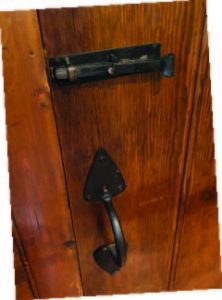
Upper Case Editorial
Michelangelo described the heavily adorned doors of Tuscany as “gates to paradise.” The entrances made for French cathedrals were perhaps the most elaborately conceived doors and doorways in history. These monumental passages were often left open during the day to let in light and air, and then “locked” at night with a big, wooden or metal bolt that fit into or slid across an iron bracket. Mortice locks (a lock system cut into the door and door jamb) were fairly rare at this time for exterior doors
From a technological stand-point, doors and doorways didn’t change much after this. Windows were incorporated into exterior doors in places where the chances of an attack were remote. In the 1700s and 1800s, interior doors began to find their way into everyday homes. Prior to that, families tended to live in one
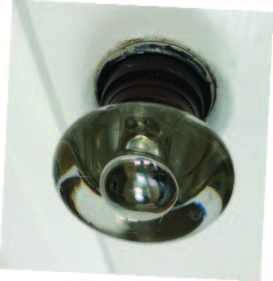
Upper Case Editorial
large, partitioned room. Doorknobs, door handles, door latches and other durable “modern” hardware began appearing during the Industrial Revolution, both in the U.S. and abroad. These finished goods were expensive prior to the days of mass production; in modest homes, doors were operated by pulling on a leather strap attached to a wooden drop-latch that was threaded through a hole in the door. In the latter part of the 19th century, during the Victorian Era, ornate hardware such as ceramic, brass or mirrored mercury-glass knobs came into vogue

Upper Case Editorial
One Good Turn
The modern lock-and-key set

Craftmaster
, unveiled by Linus Yale in 1848, is called a pin tumbler (or cylinder) lock. His son, Linus Jr., improved on this design in the 1860s. Since then, door locks have remained essentially the same, while most door keys have looked pretty much like the ones you see hanging on displays at your local hardware store. Here’s the Yales’ little secret: They actually built their empire on a concept originated in the 1780s by Englishman Joseph Bramah, a prolific inventor whose crowning achievement was the hydraulic press, a technology still in use today

Jen-Weld
OTHER MATERIALS
Okay back to the 21st century. Wooden doors are not for everyone. From a maintenance, security and energy efficiency standpoint, a metal door (below) might be a better choice. The industrial look is very popular now, too, so for certain modern homes, wood doesn’t make a lot of sense. One crucial caveat about a metal door is that it either must fit the existing framing exactly, or you’ll have to rip out the entire front entrance. Hanging a new metal door on an old frame is asking for trouble; remember, you can’t plane down metal if it rubs or sticks somewhere. In terms of durability, metal doors are great but they don’t necessarily last a lifetime. Depending on how they are constructed and the climate conditions they face, even the most expensive steel doors can “peel” over time. They can also be marred or dented, which is difficult to repair and can invite rust.

Modern Steel Door Co.
So what about fiberglass? Well, a fiberglass front door (above) would be a deal-breaker for my wife, but I wonder if she could honestly tell the difference between painted wood and top-quality painted fiberglass from more than a foot or two away. (I’m sure I’ll find out before she even finishes this story). I’m just saying “wood-grain” fiberglass products can look pretty convincing, if you ask me. The main drawback of this material is that it’s not one of the other two materials. The pros of fiberglass are many. Fiberglass doors have great insulating properties, they are more scratch- and dent-resistant than metal, and they have a similar “feel” opening and closing as wood does.
If you’re keeping score, here’s where we are: fiberglass is best from an upkeep standpoint, metal (steel) is the best for strength and security, while for most people wood holds the aesthetic advantage.
Price-wise, there are significant differences. A big, beautiful wood door can run $5,000 or more. Because they do absorb moisture, wood doors also need to be sheltered from the elements, under a porch or portico, so there may be an added expense there. Our current front door is almost four feet wide and nearly eight feet tall. It is magnificent. It is priceless. It is one-of-a-kind. However, on a humid summer day, you need to put your shoulder into it to get it all the way closed.
A top-of-the-line thick-gauge steel door will run you less than half of a comparable-quality wood door, although it’s not really fair to compare them. As I mentioned earlier, the cost may rise significantly based on what you’re replacing and the condition of the door jamb and surrounding framework. You also need to hire someone who’s done a bunch of them, and done them well. You don’t want some jack-of-all-trades learning on your dime.
Fiberglass comes in somewhere between steel and wood, even though you’ll see some advertised at bargain prices. Trust me, they are no bargain. You want a door you won’t have to think about for 20 years, and that may run you $2,000 or more installed.
One final word of advice: Be smart about choosing your installer. If you are undergoing a wallet-ectomy to buy a top-quality manufactured door, regardless of the material, give a lot of thought to who is installing it for you. Most of the top brands have trained or certified contractors to deal specifically with their doors. Really, they do. So even if you have a favorite carpenter or handy-person, you might want to look at a list of recommended installers.
What about the DIY route? Well, many years ago, I attempted to install a brand-new kitchen door in a very old house. I was young and stupid (in other words, still in my 20s) and figured a rectangle is a rectangle, a tape measure is a tape measure…how hard could this be? That door never closed without emitting the same exasperated groan my wife did the day I announced I could “do it myself.”
Later, when we were selling the house, I could sense that the prospective buyers were spending a lot of time looking at that door and wondering what else I had “fixed.” I learned my lesson: When it comes to doors, skip the Thom McAns and go for the Ferragamos. It is money well spent.
10 Unforgettable SNL Cold Opens.
On October 11, 1975, a few minutes past 11:30 pm, Chevy Chase smiled into the camera and shouted, “Live from New York, it’s Saturday Night!” In the 45 years since, the opening sketch—or “cold open,” as it’s come to be known—has defined the program through its highs and lows and ups and downs, cementing its place in entertainment history. The cold open gets its name from the idea that the audience is dropped “cold” into an in-progress story, sometimes with contextual clues or recognizable characters, sometimes not. Often the sketches are warped versions of recent news items, or merciless send-ups of public figures, particularly presidents
During the show’s first season, the cold opens were the exclusive domain of Chase, who delighted in mocking Gerald Ford’s clumsiness. In the ensuing seasons, other members of the ensemble—along with the occasional guest host—were given the honor of uttering the program’s now-famous opening line. For the record, the first non-Chevy opening was given to John Belushi, who famously threatened to betray NBC’s trust unless the network gave in to a list of demands. The ransom idea was recycled from the old National Lampoon stage show and drove home the point that the L in SNL did indeed stand for Live—and that nothing was going to happen until Belushi said it could.
Over the years, SNL’s most popular and elaborate cold opens were based on impersonations of actual people, from entertainers to politicians to regular people who had the bad luck to be in the news that week. And, as Bill Clinton, Monica Lewinsky and countless others can tell you, anything that smelled of scandal was most definitely fair game. Many of the older SNL cold opens can be difficult to find online. However, there are plenty out there to put a smile on your face. These are 10 of our favorites…
 1990 • Donald & Ivana
1990 • Donald & Ivana
Phil Hartman plays Donald Trump in a divorce settlement meeting with Ivana, played by Jan Hooks. Reviewing the details of their one-sided pre-nup agreement, he informs Ivana that she had unwittingly agreed to receive her $25 million alimony payment in the “giant stone coins of the Yap islanders” which he read about in Ripley’s Believe It or Not. Then “The Donald” beats her out of that in a double-or-nothing game of three- card Monte.
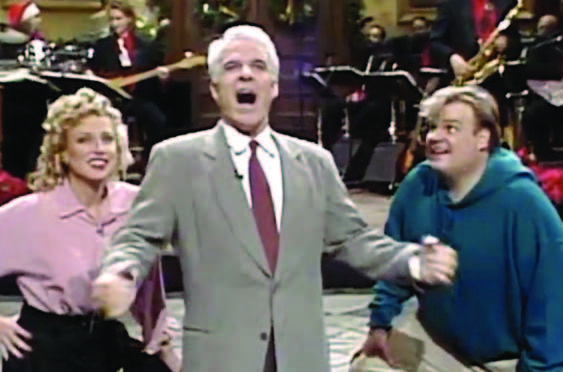 1991 • Not Gonna Phone It In Tonight
1991 • Not Gonna Phone It In Tonight
Steve Martin, remembering “when the show meant something, back when I used to care,” stars in a lavish musical number entitled “Not Going to Phone It In Tonight”—addressing criticism that he (along with other hosts and cast members) were guilty of giving less than their best at times. Everyone gets into the act, including Lorne Michaels. The performance concludes with Martin staring into the camera and saying, “Live from New York…” and then calling “Line?” It’s Martin at his best, and maybe SNL at its best, too.
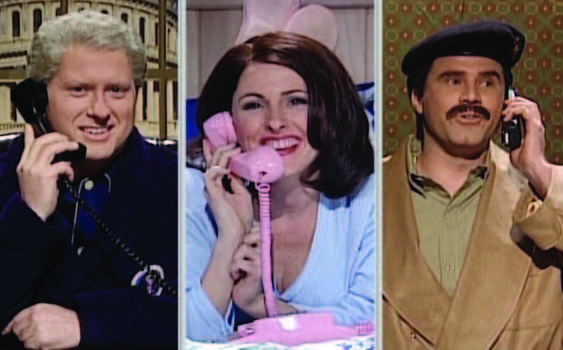 1998 • Bill, Monica, Saddam & Tim
1998 • Bill, Monica, Saddam & Tim
Bill Clinton (Darryl Hammond), Monica Lewinsky (Molly Shannon) and Saddam Hussein (Will Ferrell) engage in a smart-silly party line call. The show had a lot of fun with the Lewinsky scandal, but adding the Iraqi despot to the mix as an SNL host wannabe was a stroke of genius. And who knew Saddam’s beret was a gift from Monica? Or that he could do a Jimmy Stewart impression? Tim Meadows pops in as a fourth wheel.
 2008 • The Katie Couric Interview
2008 • The Katie Couric Interview
Among the many Sarah Palin send-ups Tina Fey performed during the 2008 presidential campaign, the best was the recreation of Palin’s disastrous interview with Katie Couric, played by Amy Poehler. The biggest laughs were reserved for lines that were barely altered from the original CBS Q&A.
 2000 • Bush V. Gore
2000 • Bush V. Gore
The real-life Bush–Gore presidential debate didn’t do Al Gore any favors. He was dreadful. Darryl Hammond captures this performance perfectly—so much so that Gore’s staff actually made him watch it. On the other side of the aisle we get to meet Will Ferrell’s “Dubya” and learn a new word: Strategery.
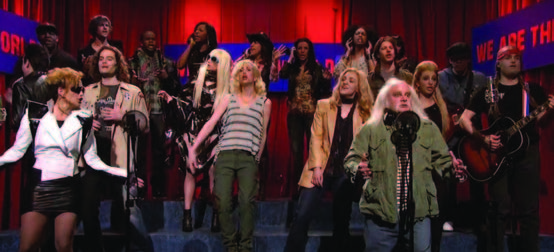 2010 • We Are the World
2010 • We Are the World
Quincy Jones (Keenan Thompson) presents “We Are the World III”—a music video to raise awareness for the disaster that was “We Are the World II,” the well-intentioned but poorly executed fundraising project for Haitian earthquake victims. Jennifer Lopez plays Rihanna, leading the cast in hilarious send-ups of contemporary pop artists. Thompson’s Quincy closes the opening with: “Hmm…that was pretty bad, too.”
 2016 • Democratic Debate
2016 • Democratic Debate
Larry David’s unforgettable debut as Bernie Sanders steals the show, but Kate McKinnon was never better as Hillary Clinton. Bernie’s rant about what’s wrong with banks—including chaining all their pens to the desks—is a classic. His best line: “I don’t have a Super PAC. I don’t even have a backpack.” Hers: “I think you’ll like the Hillary Clinton that my team has created for this debate.”
 2019 • The Cool Table
2019 • The Cool Table
Justin Trudeau (Jimmy Fallon), Emanuel Macron (Paul Rudd) and Boris Johnson (James Corden) are the bullies in the NATO cafeteria. Angela Merkel (Kate McKinnon) can’t believe she’s been invited to the cool table. President Trump is not so fortunate.
 2019 • Impeachment Talk
2019 • Impeachment Talk
It’s holiday season and we eavesdrop on three family dinners where politics are on the table…in a liberal home, a conservative home and an African-American home. The writing is brilliant and biting and uncomfortably close to the bone.
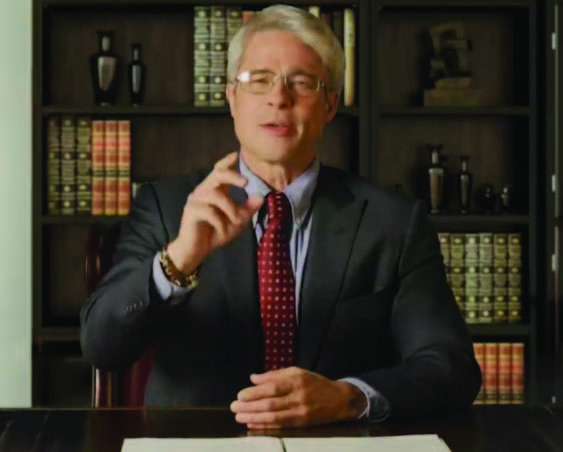 2020 • Dr. Fauci on Zoom
2020 • Dr. Fauci on Zoom
Brad Pitt, the actor Dr. Anthony Fauci joked that he’d like to play him, plays him in the midst of the COVID-19 crisis. After walking back some of the president’s confusing public statements as Fauci, Pitt removes his silver hairpiece and thanks the medical workers and first responders and their families for being on the front line.
Editor’s Note: Did we miss your personal favorite SNL cold open? Go to the EDGE Facebook page and post a link. It’s a good time and place to share a laugh.
The connective tissue between modernism and realism is not always easy to understand. Or to see. Chantell Van Erbé thrives in that space. Her intense, dreamlike mixed-media creations radiate emotion and truth…and each is a personal invitation to get a little bit lost in her mind.

A Homecoming, 2005
Colored pencil on paper, 24” x 19”

Featherscape, 1996
Colored pencil on panel, 20” x 30

Nature’s Fury, 1998
Colored pencil on paper, 17” x 14”
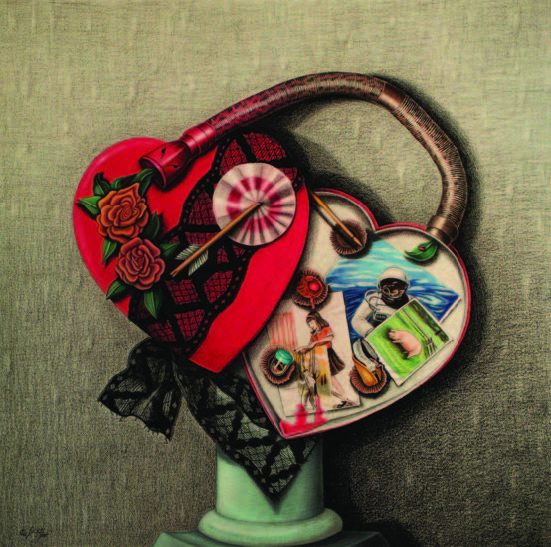
The Complexity of Emotion, 2000 Colored pencil on panel, 30” x 30”

Wise Vigil, 2004
Mixed media on panel, 18” x 24”

Transcendence, 2007
Mixed media on panel, 18” x 24”

Island: Swim Away…Disappear, 2002 Colored pencil on panel, 30” x 40”

Portals: Departure, 2019 Mixed media on panel, 36” x 24”

Portals: Arrival, 2019
Mixed media on panel, 36” x 24”
 Contemporary mixed media artist Chantell Van Erbé of North Bergen grew up in a family where art was “definitely in the blood.” Born in 1969, she drew freely on the walls of the family’s brownstone as a child in Weehawken. “I was surrounded by culture from birth,” she says, describing museums and art galleries as her “playgrounds” during the 1970s and 1980s. “I had little choice but to submit to a higher creative vision.” Painting is self-expansion, Chantell believes, a beautifully maddening and meditative process: “My technique is best described as process overflowing in transition.” Indeed, it exudes raw energy, fresh vision, bold colors and immediacy of place. Her art is less the reality she sees than the reality she remembers and, as she responds to subjects in both inner and outer worlds, she discovers new ways to encourage viewers to mindfully enter her work. “Art is a series of evolutions, numerous characterizations and endless connotations,” she says. “What tremendous power in those three letters!”
Contemporary mixed media artist Chantell Van Erbé of North Bergen grew up in a family where art was “definitely in the blood.” Born in 1969, she drew freely on the walls of the family’s brownstone as a child in Weehawken. “I was surrounded by culture from birth,” she says, describing museums and art galleries as her “playgrounds” during the 1970s and 1980s. “I had little choice but to submit to a higher creative vision.” Painting is self-expansion, Chantell believes, a beautifully maddening and meditative process: “My technique is best described as process overflowing in transition.” Indeed, it exudes raw energy, fresh vision, bold colors and immediacy of place. Her art is less the reality she sees than the reality she remembers and, as she responds to subjects in both inner and outer worlds, she discovers new ways to encourage viewers to mindfully enter her work. “Art is a series of evolutions, numerous characterizations and endless connotations,” she says. “What tremendous power in those three letters!”
Among the honors and accolades Chantell Van Erbé has received during her three-decade career was a recent solo exhibition entitled Transcendence at The Butler Institute Of American Art in Ohio. Her work was also featured earlier this year at the National Arts Club in New York in support of the Metropolitan Museum of Art.
—Tova Navarra
On October 27th, mental health advocate Zak Williams shares the virtual stage with Jack Ford at the Trinitas Health Foundation’s Peace of Mind Event. The son of actor and comedian Robin Williams, Zak has focused his entrepreneurial skills on mental health advocacy. He will be sharing his personal story to address the challenges and stigma associated with mental health issues. He is the former Chief Operating Officer of Crossing Minds and Director of Business Development for Condé Nast, and a graduate of Columbia Business School.
EDGE: How would you characterize your approach to mental health advocacy?
ZW: My approach is primarily systems-based— how we think about making a difference across a collection of avenues to ultimately provide a better, more comprehensive approach for individuals and communities.
EDGE: Is that more dependent on top-down or bottom-up strategies as a catalyst for good things to happen?
ZW: It involves taking both a bottom-up and top- down approach. It requires grassroots initiatives—people understanding the needs of people—as well as top-down policy considerations, organizational considerations and considerations in the private sector. Also cultural considerations, which involve both bottom-up and top-down strategies.
EDGE: What does a systems-based approach to advocacy in this space look like?
ZW: I break things down into five categories where change can happen: Programming, which involves development of curricula and potential applications; Experience, which involves mental health awareness and campaigns focused on, for example, reducing stigma; Research, which is done by institutions nationally and abroad; Advocacy, involving strategic thinking and how organizations and different constituents communicate and coordinate around making change; and then there’s Policy, which occurs mainly in the public sector and includes educating policymakers to make pragmatic and thoughtful decisions about crafting policy that ultimately impact their constituents for the best.
EDGE: I hear the entrepreneur in you talking. What strengths do you bring from that realm to this one?
ZW: My role as an advocate bleeds into what I do in the private sector. In terms of how I operate as a business executive, as I said I’m very much a systems-based advocate. I rely upon metrics and data to make decisions. But for me it’s very much about establishing belief systems that impact society, culture and people for the better. You can take an advocacy approach whether you’re in the private sector or the not-for-profit world. It’s just a particular style of management and organization and leadership
EDGE: When you speak at events like the one for Trinitas, is it similar to giving a presentation in front of a group of potential investors?
ZW: It’s exactly like giving a presentation in front of a group of investors. The key thing is tying storytelling to impact and data. If you can tell a story with the numbers, it’s extremely compelling because, at the end of the day, the human element of mental health support and advocacy is absolutely critical. The numbers element helps tell a story at scale. So tying the two together is critical for sustained investment into the category.
EDGE: Because of its proximity to both urban and suburban populations, Trinitas extends its mental health service to a very wide and diverse audience. Is that type of “parity” the focus of most advocacy organizations?
ZW: Yes it is, especially on a policy basis. From a technical standpoint, it can be boiled down to something pretty straightforward, which is providing a foundation for mandating that insurers provide equal coverage around mental health programs. That is extremely important when it comes to providing quality of care. So organizations that take a leadership role within the space of mental health parity are on the vanguard of what mental health support will look like.
EDGE: And what will it look like?
ZW: Expanded services and high-quality care for all constituencies that need it. We’re getting there. Slowly. The California state legislature recently passed a mental health parity law that ultimately mandates that insurers take an egalitarian approach to providing services. People deserve high-quality care across the board, regardless of whether they come from means or they don’t. The more we can think about how to implement that on a systems level, the more people will have access to preventative care, just as they have access to chronic and crisis-oriented care.
EDGE: What role do you think technology will play in moving this forward
ZW: I’m taking Dr. Ronald Kessler’s lens here in terms of how he talks about technology. He’s an epidemiologist and policy expert at Harvard Medical School. He says there are “tech extenders” and “people extenders.” Tech extenders are telehealth platforms that enable care to be extended to places that might not have in-person, offline resources that would enable people to have the quality of care that they need. People extenders would include providing behavioral coaching services and additional social services, whatever they may be, training people to create higher-quality coverage in areas and regions that might not have, say, the level of psychiatrists needed across an entire population. So that might look like behavioral coaches or students or residents that can provide preventative-level care before it becomes a chronic or crisis issue requiring psychiatric interventions. You want to match people to the level of care that’s needed.
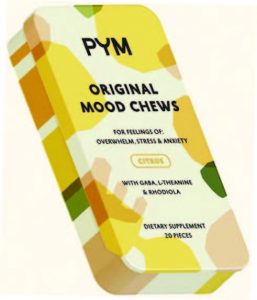 Prepare for Takeoff
Prepare for Takeoff
In 2020, Zak Williams launched a new company, PYM Health. PYM stands for Prepare Your Mind. According to Williams, it is focused on “providing lightweight to middleweight solutions for stress and anxiety,” he says. “Our first product is a chew that contains primarily natural amino acid compounds that provide stress/anxiety support.”
Original Mood Chews are available online through the company’s website and other ecommerce channels. “Ultimately, we hope to be available in stores throughout the nation,” Williams says.
EDGE: What other goals do you have in the area of mental health advocacy?
ZW: The privilege of being able to do the work I do is something that I hope other people will explore. Within the communities that I’m a part of, we hope to empower others to advocate for causes associated with mental health. Ultimately, I hope to support people along their journey and create more communities of advocates that will create change on a systems level. The fact that we’re able to have this conversation, I’m very grateful.
EDGE: Going from “son of…” to “father of…” status is a turning point for a lot of people, whether your dad is a celebrity, as yours was, or not. In what ways has fatherhood changed your perspective?
ZW: When it comes to raising my son, to parenting, it’s caused me to prioritize empathy and openness and understanding. It has certainly changed my perspective in how I think about mental health advocacy and advocating for change. My son is 15 months old. He doesn’t think about mental health, but I am very heartened by how young people think about mental health and the stigma associated with it. I’m 37, which I guess makes me a late-stage Millennial. Generations younger than myself tend to have an openness and orientation toward thinking about mental health as being essential to a balanced and healthy lifestyle. I want to take the long view here, that future generations have an opportunity to remove the stigma and biases associated with mental health and ultimately create a more tolerant society and world.

Photo courtesy of Zak Williams
Zak is on the board of Bring Change to Mind (bringchange2mind.org), a nonprofit founded by Glenn Close, that works to end the stigma and discrimination surrounding mental illness. He’s an advisor for Inseparable (inseparable.us), a national organization focused on creating pragmatic mental health policy.
Trinitas helps get Tony Testa back on his feet.
By Erik Slagle
Tony Testa’s life has always been about giving it his all for the fans. As the original guitarist for the beloved doo-wop group The Duprees—and now their leader and frontman—Testa’s charisma and give-and-take with the audience make every show dynamic and unforgettable. The band formed in the early 1960s in Jersey City and shot to fame with hits like “You Belong to Me,” “It’s No Sin” and the classic “Have You Heard.”
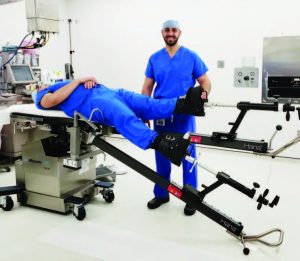 Extensive touring and physical wear and tear on Testa over the years resulted in a hip condition that took him off his feet earlier this year. A born performer, Testa knew he couldn’t take chances with anything other than the best care and technology when it came to receiving an artificial hip—a critical joint for someone who needs to command the stage for a living. After researching hip replacement procedures, Testa decided to seek out a facility that uses the Hana Orthopedic Table (right) in its OR. The Hana Table has transformed how hip replacement surgeries are carried out: patient positioning via the table means the surgery can be minimally invasive, less painful, and with much faster recovery time. It all adds up to a vastly improved experience compared to hip replacements of even the recent past. A friend who had recently undergone surgery of his own recommended that Testa—who lives in Jackson Township—look into the work being done at Trinitas, which uses the Hana Table in its OR. After speaking to another friend, Nadine Brechner, Chief Development Officer and Vice President of the Trinitas Health Foundation, Testa chose Trinitas even though Elizabeth is 50-plus miles north of his home.
Extensive touring and physical wear and tear on Testa over the years resulted in a hip condition that took him off his feet earlier this year. A born performer, Testa knew he couldn’t take chances with anything other than the best care and technology when it came to receiving an artificial hip—a critical joint for someone who needs to command the stage for a living. After researching hip replacement procedures, Testa decided to seek out a facility that uses the Hana Orthopedic Table (right) in its OR. The Hana Table has transformed how hip replacement surgeries are carried out: patient positioning via the table means the surgery can be minimally invasive, less painful, and with much faster recovery time. It all adds up to a vastly improved experience compared to hip replacements of even the recent past. A friend who had recently undergone surgery of his own recommended that Testa—who lives in Jackson Township—look into the work being done at Trinitas, which uses the Hana Table in its OR. After speaking to another friend, Nadine Brechner, Chief Development Officer and Vice President of the Trinitas Health Foundation, Testa chose Trinitas even though Elizabeth is 50-plus miles north of his home.
“I’ve known Nadine Brechner for some time now, and she told me about the facilities and staff there who could perform my hip replacement,” Testa says. “I made the decision that Trinitas, even though it was a little far, would be the best place to have this surgery.”
Then, however, came COVID-19. The pandemic caused many to rethink the decision to undergo elective surgeries. Testa, though, says he never seriously considered postponing his operation: “I was reasonably sure it would be safe. Hospitals are always ensuring of a healthy and clean environment, and given the crisis, I was especially confident every precaution would be taken.”
For Testa, who like other entertainers had his touring schedule postponed, the timing was ideal, as he would have plenty of time to recover and recuperate. Live concerts for The Duprees—and special events like Holland America’s Malt Shop Cruise, which features the group in its all-star lineup—are set to resume sometime in 2021.
The effort to get Testa back into the spotlight co-starred orthopedic surgeon Dr. Mark Ghobrial, anesthesiologist (and Chair of the Department of Anesthesiology) Dr. Leon Pirak and the Trinitas nursing team—all of whom Testa describes as “nothing short of incredible
As New Jersey flattened its curve and hospitalizations began slowing in the spring, Testa’s procedure was carried out as planned. In fact, with extra safety measures and disinfection procedures in place, hospitals soon became some of the safest places to be in terms of potential COVID-19 exposure. Trinitas, of course, was no exception.

The Duprees
“The whole staff was extremely attentive to health and safety protocols,” Testa says. “They made sure everyone had masks, were always taking people’s temperatures and wiping everything down. As a patient, I never felt unsafe or like corners were being cut. Dr. Ghobrial was terrific. Dr. Pirak? Top-notch. And the nurses, I can’t say enough about them. I would recommend Trinitas to everyone. I had the surgery on a Tuesday and was out of the hospital by Thursday morning. I was walking again almost immediately
According to Testa, he could have been back on stage by September. Whenever that happens, for fans of the Duprees, it won’t be a moment too soon.
When New Jersey desperately needed more nurses, Trinitas grads answered the call…in record numbers.
By Erik Slagle
Unprecedented. Among the myriad adjectives we’ll be using to capture the magnitude of 2020 in the years to come, unprecedented might not be as vivid as devastating or frightening or horrifying, but it captures the positive along with the negative—and that makes it a word we should embrace. For instance, the dedication and courage of healthcare professionals in the face of a tsunami of unknowns brought about by COVID-19 was truly unprecedented, although hardly surprising. At Trinitas and other hospitals around the state, workers put their lives on the line every day because, well, that’s what they do, isn’t it?
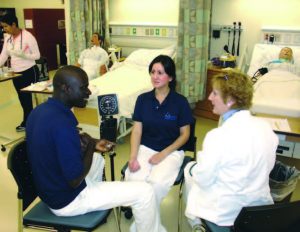 Also unprecedented in 2020 was the surge in interest among young New Jerseyans in entering the healthcare field—specifically nursing—at a time when there was no small amount of risk accompanying that decision.
Also unprecedented in 2020 was the surge in interest among young New Jerseyans in entering the healthcare field—specifically nursing—at a time when there was no small amount of risk accompanying that decision.
The 2020 graduating class of the Trinitas School of Nursing was the largest ever, with nearly 190 graduates immediately entering the workforce when their communities needed them most—a new generation of frontline heroes joined the fight against the pandemic.
“COVID-19 actually affirmed, for me, that I made the right decision in starting a nursing career,” says Patience Opaola, who graduated from the School of Nursing in January and now works at Trinitas as a registered nurse (RN). After graduating from Linden High School in 2016, she started her RN education at 18, unsure of where she should go next in life. Opaola admits it wasn’t an easy adjustment moving later from the classroom to the front lines, but says she was met with a great deal of support.
“I wanted to quit so many times,” she says of her early days on the Medical-Surgical floor. “But I’m glad I saw it through. You learn how to ask for help…everyone’s ready to lend a hand.”
“These nurses and students are amazing individuals who want to work with patients that are very, very sick,” says Dr. Roseminda Santee, Dean of the Trinitas School of Nursing. “Our students want to serve their communities and take on the challenge of the COVID-19 battle.”
Between January and May, a record 188 graduates earned their credentials at Trinitas, and Dr. Santee says that, during the worst months of the pandemic, the school continued to see extraordinarily high numbers of applicants. Most were new to the healthcare field, while some were Certified Nurse Aides or Licensed Practical Nurses, completing their education to become RNs. The cohort overall was a diverse mix of ethnic and cultural backgrounds, and included a number of male candidates, as well—more so than usual, according to Dr. Santee.
The coronavirus outbreak, of course, forced the physical closure of schools at all levels, and the School of Nursing had to quickly pivot toward online instruction. Faculty and students alike stepped up and made the transition a smooth one. Looking ahead toward 2021, challenges are likely to continue until an effective vaccine is made widely available, as social-distancing measures limit the number of seats permitted in each class. However, says Dr. Santee, the school is up to the task.
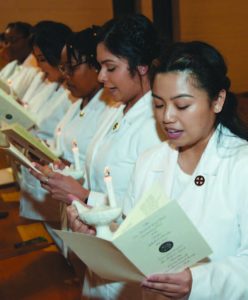 “I wish I could take every single one of our applicants,” she says, noting that some will have to be waitlisted. “It’s a balancing act, meeting the New Jersey Board of Nursing demand for more licensed nurses while adhering to state-mandated health protocols in our classrooms. We also have to bear in mind the guidelines required by the New Jersey Office of the Secretary of Higher Education.”
“I wish I could take every single one of our applicants,” she says, noting that some will have to be waitlisted. “It’s a balancing act, meeting the New Jersey Board of Nursing demand for more licensed nurses while adhering to state-mandated health protocols in our classrooms. We also have to bear in mind the guidelines required by the New Jersey Office of the Secretary of Higher Education.”
The school’s ability to master that balancing act helped garner its fourth designation as a Center of Excellence in Nursing Education by the National League for Nursing—one of only 17 institutions across the country to receive the recognition for another four years. The relationship between Trinitas and Union County College is a key to the School of Nursing’s ongoing success.
“Trinitas has been such an open and helpful partner,” she adds. “It’s a collaborative effort between the hospital and college to ensure we’re meeting the standards of nursing education and graduating enough nurses to meet the hiring needs of our healthcare facilities.”
To help meet demand, the New Jersey Board of Nursing has approved “temp” new graduate nurse hiring, meaning candidates receive temporary work permits while waiting to take the licensing examination. These exams were also impacted by COVID-19 because of the social-distancing requirement for examinees.
For more than a decade, the Trinitas School of Nursing has enjoyed a reputation for rigorous curricula, an outstanding teaching staff, and an admissions policy ensuring that only the best students—representative of the community served by the school—are admitted as future healthcare professionals. Based on recent applicants, enrollees and graduates, the school will maintain its status as one of New Jersey’s top destinations for students looking to lead the fight for our nation’s health for years to come.
“Getting into the hospital after finishing school may be a bit of a shock,” says Opaola, reflecting on her advice to others thinking of following her path. “You might feel small in the beginning, but you’ll have a lot of support. And that support starts with your faculty and classmates at the School of Nursing.”
DID YOU KNOW?
The World Health Organization Designated 2020 as the International Year of the Nurse and Midwife in honor of the 200th “birthday” of Florence Nightingale.

Fox Broadcasting Company
There is an art to delivering a scripted line and John Slattery has all but mastered it. When his characters speak, we not only listen. We want to know everything about them. As Roger Sterling on Mad Men, he offered a window into the brand-building culture of 1960s America and, as Paul LeBlanc in the new Fox series neXt, he is our guide to the chilling prospect of artificial intelligence run amok. Gerry Strauss was curious about the origin of Slattery’s talent for boiling down big television and film concepts into elegant, intimate and often funny moments. Not surprisingly, it was honed live on stage.
EDGE: What drew you to acting as a young man?
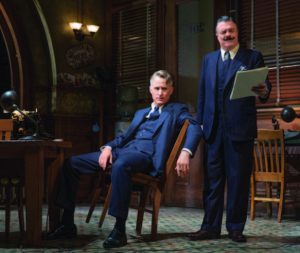
Broadway.com
JS: I watched a lot of movies and TV when I was a kid and, somewhere in there, I realized that people were actually doing this as a job…and maybe I could do that. I had to apply to college somewhere and there was a school—Catholic University in Washington, DC—that my sister had gone to. I was not a very good student and my options were probably not that great. It was the only place I applied. If I didn’t get in there, I was going to have to figure something else out. I got in and they had a theater department, so that’s how I started.
EDGE: Your stage résumé is very extensive. Do you actively pursue theater work in between your television and film projects?
JS: Absolutely. One of my favorite things is to be able to do various disciplines. There are different rhythms to all of them. When I went to New York, my first legit jobs were commercials and stuff like that—which are great jobs to have and you learn a lot. But as far as acting, I learned on the stage. It’s thrilling and difficult in a different kind of way. It tests you and your ability to repeat the whole process every night and rehearse for a sustained period of time. So it’s just completely different than anything involving a camera. Hopefully, that is something that people will still be able to do.
EDGE: How did John Slattery become Roger Sterling?
JS: Matt Weiner saw me in a play. I was doing Rabbit Hole on Broadway with Cynthia Nixon and Tyne Daly. I went in to read for the part of Don Draper; that’s because the part of Roger didn’t have a lot to do in the pilot. And then, after I read a couple different times and did my homework and prepared, he said, “Well, here’s the thing…[laughs]…we have that guy already.” That actually happened. Matt claims that I was in a bad mood the whole time we shot the pilot because I didn’t think that my part was good enough, and my nose was out of joint because he made me read for Don Draper.
EDGE: Were you in a bad mood?
JS: I don’t know. But I probably had one foot out the door, because no one knew what Mad Men was going to turn out to be, since AMC hadn’t done very much original programming. Anyway, Matt promised me it would be a great part…and it was.
EDGE: When the series concluded, were you concerned that future projects might not meet the untouchable quality standards that you’d become accustomed to as a part of that show?
JS: No, not even a little bit. I’m not looking for Mad Men. I’ve done that and I had a great time doing it. I never expected it to happen in the first place, and I don’t expect it to happen again. That said, I went on and did Spotlight, which was pretty great—great circumstance, great people. I just try to find the material that speaks to me. Sometimes it works out and sometimes it doesn’t. But that’s okay, too. If you can find something that satisfies you, then I’m good with that.
EDGE: You’ve played a lot of bosses and high-ranking employees. Does each take a particular kind of preparation?
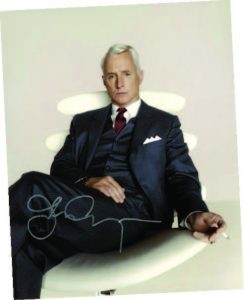
Upper Case Editorial
JS: I’ll do my research, the required homework in order to make myself as convincing as possible. But people are in positions of authority for all kinds of reasons, whether they know their job, or whether they they’re just good with people, or whether their brother-in-law runs the company. For example, in Mad Men, I played a guy whose name is on the building, but it’s because his father founded the company. However, If you said that to him, he’d say, “What does that have to do with anything? Are you trying to tell me that I don’t know how to do my job?” There isn’t any one quality that is required to have that job.
EDGE: neXt has been quite the addition to Fox’s lineup this season. What appealed to you about the concept of the show?
JS: The character appealed to me because this guy created this artificial intelligence, and he immediately recognizes the potential dangers of and tries to lock it away. In his absence, it’s unlocked and plugged into the internet and it starts to run amok, and he’s trying to warn people how dangerous it is. I was interested in exploring how do you describe exponential growth and tell someone the planet’s burning? So he’s trying to describe to people how super intelligence works and why it’s dangerous. You give this thing an order on Friday and over the weekend it learns the 20,000 years of human history—you think it might take issue with you being its boss on Monday morning? I say a line in the show—“You know, in your lifetime, you’ll kill maybe 100,000 bugs with your car. You don’t mean to…they’re just in the way. That’s what we are to this thing.”
EDGE: People look at your character Paul like he’s crazy.
JS: Because he is kind of crazy. He has this brain disease, and he’s hallucinating and he’s paranoid and he’s anxious. People are put off by him and don’t really want to listen to what he has to say. So it’s that combination that made the whole role a really interesting exercise—and makes it a thrilling show. You asked the question about how I approach playing people in positions of authority? So I don’t know anything about super intelligence. I read a couple of books and watched Sam Harris give a couple of lectures. I listened to Elon Musk and Bill Gates trying to explain it. You go So how do I do that? I had to learn how to get my mouth around some of the technical terms that that need to be second nature to my character and I have to communicate with a degree of authority—as well as an off-handed quality—that really smart people have [laughs].
EDGE: With so much streaming content that gets binged and forgotten until a new season drops, do you think there is a benefit to having series like neXt air one episode a week—so that suspense builds, storylines develop and buzz gets generated?

Fox Broadcasting Company
JS: It’s a good question. I just finished watching a show called The Bureau. It’s a French spy show. They had already made four seasons of it, so I binged four seasons of it. I thought there were five and was expecting to watch the fifth next, and then I realized that the new season hadn’t come out yet. Then, the fifth season was on week to week [laughs] so I had to watch the thing every week and wait for them one at a time. I was kind of pissed in the beginning, but it didn’t keep me from turning it on. You can binge something and you can crank through the story in a couple of days, which is great. But there still is that anticipation if you know how to hook the audience. You’ve got to have a good couple of shows up top, kicking the thing off and setting the hook as it were to the audience—which I think we do. You’re not trying to manipulate anybody, but you’re trying to get them interested in the story you’re telling. There’s so much entertainment out there, and people’s lives are so filled with media of one kind or another, that it’s hard to make a dent. I think this show does. I really do. And I think it’s more timely now than when we made it six months ago.

Marvel Studios
Iron Man’s Dad
Fans of the Marvel Cinematic Universe know John Slattery as Howard Stark, Tony Stark’s father, a character presented in flashbacks since he was murdered before the current-day setting. How did John land this role?
I wasn’t a big comic book fan—not since I was a kid, so I really didn’t have that much of a pull towards it. I got a call from Jon Favreau, who directed the first two Iron Man movies. “Do you have any children?” I said, “Yeah…”, and he said, “You have to do this then. I mean, how are you going to tell your kid that you had a chance to play Howard Stark and you turned it down?”
When I did scenes with Robert Downey, there’s a script and we rehearse it and then we change it. It wasn’t like a total improv, but there was a lot of stuff that we were just trying to figure out. You have to figure out the best way to tell the story of the film and try to figure out where the scene lives. It was really fun to do that with Downey and the Russo brothers, who are such smart guys.
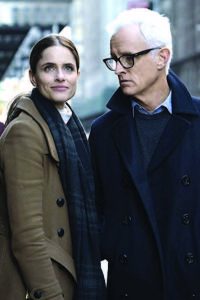
Amazon Studios/Prime Video
The Spice of Life
Is it fun for you to pop into an episode of The Romanoffs or a film role that doesn’t involve a long-term commitment?
Yeah! Variety is part of the reason I went into this business. You can play different people and learn to do a variety of different jobs, but you don’t have to actually stick with them. Sometimes the short assignment can be preferable, depending on where my life is at the moment. Sometimes it’s tricky because you don’t have as much information about the story to go on. Then again, you have to remember that because a show like Mad Men happens one scene at a time, so you don’t really know a character in its entirety until you get to the end.
In the new normal of compulsory facial coverings, we tip our hat to those who’ve been rocking them all along. Here is our totally arbitrary, unscientific Top 25 favorite mask wearers…
Incognito
They wore a mask to protect their identities…
 Dread Pirate Roberts
Dread Pirate Roberts
Or Westley, handsome hero of The Princess Bride
 Sister Knight
Sister Knight
Friend of EDGE Regina King got wrapped up in this Watchmen role.
 Bat Girl
Bat Girl
Uh-oh. Don’t let Commissioner Gordon find out.
 Erik (aka Phantom of the Opera)
Erik (aka Phantom of the Opera)
Lifted his mask for that famous first kiss.
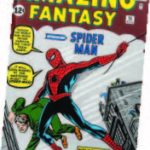 Spider-Man
Spider-Man
Do we think that’s an N95?
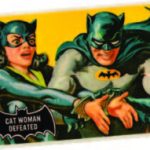 Batman
Batman
His cowl looks more uncomfortable with each new movie.
Catwoman
Never entirely house trained.
 Zorro
Zorro
You’d think the moustache would give him away, right?
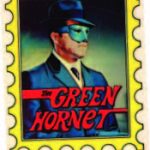 Green Hornet
Green Hornet
Crime-fighting editor? We can get behind that.
 Lone Ranger
Lone Ranger
Fun Fact: His grand-nephew was the Green Hornet.
 Racer X
Racer X
Speed Racer’s brother, Rex. Rex Racer. Racer X. Hello?
 V (for Vendetta)
V (for Vendetta)
Matrix bad guy Hugo Weaving played the anarchist in the Guy Fawkes disguise.
Look Sharp
They wore a mask to complete their ensembles…
 El Santo
El Santo
Most famous of Mexico’s “luchador” masked wrestling champions, Rodolfo Guzmán Huerta starred in more than 50 movies!
 Captain America
Captain America
Unclear why he needs the half-mask, especially on a humid day.
 The Phantom
The Phantom
The guy lived on a remote island in a purple jumpsuit so clearly just bored.
 The Flash
The Flash
Lightning bolts on the side are awesome.
 Green Lantern
Green Lantern
Actually, not all Green Lanterns wore a mask so it was definitely a fashion choice.
 Hit Girl
Hit Girl
Teenage comic book vigilante has become a go-to Halloween costume.
Don’t Ask
They wore a mask because, well, we just don’t know…
 Stanley Ipkiss
Stanley Ipkiss
The first guy to discover and wear The Mask, made famous by Jim Carrey in the 1994 Hollywood mega-hit.
 Jason Voorhees
Jason Voorhees
The rampaging killer of teen scream slasher nightmares didn’t don his trademark hockey mask until Friday the 13th Part III, in 1982.
Safety First
They wore a mask because they had to…
 Ironman
Ironman
No secret who’s inside.
 The Mandalorian
The Mandalorian
Helmeted star of Disney+
 Hawkeye Pierce
Hawkeye Pierce
“I’ll heal their wounds, treat their wounds, bind their wounds, but I will not inflict their wounds.”
 Yogi Berra
Yogi Berra
Would his face have looked much different without one?
 Darth Vader
Darth Vader
B-b-b-breathless!
Photo credits:
Pirate Roberts • Quantum Mechanix Sister Knight • Mark Hill HBO
Bat Girl • Upper Case Editorial
Spider Man • Marvel Comics
Batman Cat Woman • Topps Inc.
Zorro • Dell Comics
Green Hornet • Greenway Productions Inc. Lone Ranger • Dell Comics
Vendetta • Amazon.com
El Santo • Upper Case Editorial
The Phantom • Upper Case Editorial
The Flash • IMDB Comic-Con
Green Lantern • SkyBox International
The Mask • Upper Case Editorial
Ironman • Christopher Favero GeekTechLive Hawkeye • Donruss Inc.
Yogi Berra • Upper Case Editorial
Darth Vader • Jake Sloan Alaska Vader
Three-time U.S. Open doubles champion
Was there something extra-special about winning your own country’s championship?
Yeah, of course—it felt great. Everybody knows the U.S. Open. You won the U.S. Open? Well, that’s pretty cool. There was a lot of pressure. It’s one of the two biggest tournaments of the year. In doubles, John [McEnroe] and I wanted to win. In singles, I don’t think it ever entered my mind that I had a chance to win, but I wanted to do well. It was a big two weeks.
How did you get to know John and become his doubles partner?
I met him when he was 12. We both were training at Port Washington. I’m four years older, so that’s a big age difference, but we were still quite good friends because he was definitely a precocious kid. He didn’t act like he was 12. The summer that he got to the Wimbledon semifinals, in 1977, we became really good friends and literally, we were hanging out every day. We both did well in doubles tournaments with other partners. It was kind of just an organic thing: Maybe we should try and play together. It seemed to be the most natural thing to be able to travel to the same tournaments and be in the same matches. We thought it would work out really well, which is what happened.
When you were growing up in Chatham, it was the height of the tennis boom. What was the competition like at the junior level here in New Jersey?
There weren’t a million future pros. The god of New Jersey tennis was Jeff Miller. Jeff grew up in Scotch Plains and he was beating the best players—the best men player—in the state at age 14. He was amazing. Jeff was two years older than me. I couldn’t have competed with him in a million years. I won the state tournament the year after he graduated, as a junior.
When you joined the men’s tour after college, you were stepping on the court with players like Bjorn Borg, Guillermo Vilas, Jimmy Connors, Ilie Nastase…how do you not feel intimidated?
When I was in college I had the opportunity to play in tournaments with pros and I beat some top-ranked guys and lost close matches to other ones. Obviously you are nervous, but also excited to match skills with them. Then I became such good friends with John McEnroe and practiced with him every day for maybe two years. As he improved and suddenly became one of those icons, I would say C’mon, I’ve beaten this guy plenty of times. You know, so much of doing anything is about belief. Do you believe it can happen? Then it can. If you don’t believe it can happen, it’s not gonna. Plain and simple.
Editor’s Note: Peter Fleming won 60 doubles titles during his career, including four Wimbledons and three U.S. Opens. He was the world’s #1-ranked doubles player in the mid-1980s and achieved a #8 world ranking in singles in 1980. Peter lives in England and works as a tennis commentator. He graduated from UCLA and is a member of the Intercollegiate Tennis Hall of Fame.
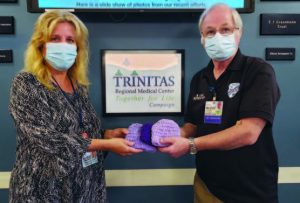 PURPLE HATS FOR NEWBORN NOGGINS
PURPLE HATS FOR NEWBORN NOGGINS
The Stitch Club of the Church of the Holy Innocents in West Orange lovingly crafted purple hats for babies at Trinitas in support of Shaken Baby Syndrome Month, observed in September. Michael Lisa, Trinitas CPR instructor, also the husband of Stitch Club member Robin Lisa, made the annual delivery to Hana Baudendistel, MS, BSN, RN, NE-BC, Clinical Information Systems Design Coordinator.
 WATCH THE PRESIDENT OF TRINITAS SOAR!
WATCH THE PRESIDENT OF TRINITAS SOAR!
The SOAR! 34th annual New York Awards Gala honored Trinitas President/CEO Gary S. Horan, FACHE with the Saint Elizabeth Ann Seton Award at the virtual event in September. Horan is a former member of the Board of Directors of SOAR! (Support Our Aging Religious). This national organization provides grants to help Catholic religious congregations in the US care for their elderly and infirm members.

BEHAVIORAL HEALTH LEADER
Salvatore G. Savatta, MD has been appointed the Chairman of Behavioral Health and Psychiatry at Trinitas. Dr. Savatta previously served as the Interim Chairman of the Department since 2019.
Dr. Savatta is Board Certified in Adult Psychiatry. He received his Bachelor of Arts Degree in Economics from New York University and his M.D. from NYU School of Medicine. In addition, he holds a M.S. in Biostatistics Clinical Research Methods from Columbia University Mailman School of Public Health. Prior to completing his Psychiatry Residency at St. Vincent’s Catholic Medical Center, he served three years as a surgical resident. He also completed a Forensic Psychiatry Fellowship at University of Pittsburgh Medical Center – Western Psychiatric Institute and Clinic.
 FOR THE LOVE OF MIDWIVES
FOR THE LOVE OF MIDWIVES
When Nikita Lazo of Union delivered her baby, Dylan Ramirez, she wanted to let the midwives at Trinitas know how thrilled she was with her birthing experience.
“Carol Rose-Trzaska my midwife was wonderful,” Nikita said. “She was so sweet and helpful to me; I felt very comfortable with her since day one. When I met her I liked the way she explained everything to me and also listened to what I had to say. She was more of a mother to me. Shanaya Recalde, CNM, helped me with breastfeeding and showed me what to do so it wasn’t painful. Other nurses like Pat Henn, Analisa Rameriz, and Margaret Waldrop, were also very helpful. I would recommend them and rate them 10 stars. I will always remember that team.”
 DRIVEN BY THE GOSPEL
DRIVEN BY THE GOSPEL
The Pastoral Care Department at Trinitas celebrates Father Stephen Chukwuemeka Aribe’s 25 years as a priest. Father Stephen was ordained a Catholic Priest on July 15, 1995, at Mater Dei Cathedral in Umuahia Diocese in the Eastern region of Nigeria. As he has been a committed, dedicated servant of God, Father Stephen says, it’s important to add, “driven by the Gospel of Truth.”
 DOCTOR FOR THE WOUNDED
DOCTOR FOR THE WOUNDED
Dr. Michael R. Zaboski has joined the Trinitas Center for Wound Healing & Hyperbaric Medicine. Known for his razor-sharp memory and calming presence, Dr. Zaboski is a true asset to the team. He is no stranger to wound care. While attending medical school at Saint George’s University School of Medicine, he received extensive experience in wound care management in his surgical rotation at Queen Alexandria Hospital in Portsmouth, England. He was named Chief Resident at St. Elizabeth Hospital in what is now the Rutgers New Jersey Medical School/Trinitas Regional Medical Center Internal Medicine Residency Program.
What’s in store for New Jersey’s adventurous eaters? You name it.
By Andy Clurfeld
Remember trying to guess the number of jelly beans packed into a big glass jar at a county fair? I was never good enough at math to come up with a reasonable jelly-bean-per-square inch count that I could multiply by jar height and width to hazard a reasonable count. I admired those who even approached a ballpark number. After speaking with dozens and dozens of culinary professionals as indoor dining in New Jersey was coming out of its long hibernation, I learned I’m in ample company in the “it’s anybody’s guess” department: Nobody in this COVID-canceled-it world can say with any certainty what the state of our restaurants will be as the year 2020 winds down.

www.istockphoto.com
Although we may not know what’s in store, I’ve got a pretty good idea of what’s actually in Garden State stores, which carry a world of foods. So what I set about doing, rather than a review or profile a restaurant that might be in flux, in re-set, in one sort of modification or other by the time you read this, was to shop markets outside the general stock-up norm and see what’s available— specifically, what might bring to your home table the spirit of dining out.
Mind you, I wasn’t looking for our old standby favorite, the rotisserie chicken. I wasn’t parsing the deli counters for cold cuts and three-bean salads. Nor was I grabbing prepared skewered beef cubes and bell peppers for the grill at the meat counter or marinated tuna chunks in the seafood department. I was hankering for more exotic tastes, a smack of adventure, a journey to another land on a plate.
And I found those experiences at New Jersey’s bountiful ethnic mega-markets.

Fattal’s Bakery
From the true super-size stores, such as Hmart (Korean/Asian), Netcost (Russian/Eastern European), City Fresh Market (Latin American), Seabra Foods (Portuguese/Brazilian), Mitsuwa (Japanese/Asian); Patel Brothers (Indian), Supremo (Latin American) and Kam Man (all-Asian), to the more intimate shops, including Chowpatty (Indian), Fattal’s (Middle Eastern), Nouri Brothers (Syrian/Middle Eastern), Piast (Polish), Makola African Market and The Greek Store, to the beloved neighborhood-centric Mexican and Indian corner stores, there’s a veritable United Nations of foods in our midst.
Consider stamping your dining table much as you would your passport, with a global menu of meals. I can vouch for finding food-shopping happiness at all the markets noted above—and experiencing the joyful, delicious meals that result with little or no effort. In fact, I often tell dinner guests who compliment my cooking that I’m not a particularly talented cook, but I am a very good shopper
Want some examples? There really are no recipes here…just mealtime put-togethers at a variety of price points.

Photo by Andy Clurfeld
Let’s start easy, seriously easy, with a completely ready-to-eat meal from Hmart, which has stores in North and Central New Jersey. We’ll progress to an elegant appetizer (or even an entrée) that’s assembled from prepared and purchased foods at Netcost. Then we’ll do what I think of as the two-step: quick and easy two-element bites that elevate your eating game.
So rev up those taste buds and stretch your palate.
Hmart sells myriad and many prepared foods, including sensational Korean kimbap rolls, which look like Japanese sushi rolls, but spotlight vegetables instead. Buy a package of those and partner with an “egg” roll, an omelet-like layering of scrambled-then-cooked egg punctuated by peppers and onions and lined with nori sheets, a skinny version of a handroll known as a “finger” roll, and a petite side of cucumber-sesame salad. Use the pickled vegetables that come with the rolls to garnish and punch up the prettiness of the plate

Piast Meats & Provisions
NetCost, with Jersey stores in Paramus and Manalapan, is world headquarters (well, my personal world head-quarters) for caviar and many other Russian and Eastern European foods. Now, caviar isn’t everyday fare for me, but when I want to do something special, I layer in a ring mold a few things I find in this uber-market’s extensive prepared foods sections (a chunky, creamy salad of potato, peas, onions, peppers; an egg-based salad; slices of smoked salmon) plus one of the thick, rich Russian sour creams NetCost sells (doctored with snippets of fresh chives and sliced scallions) and, slathered on top, a generous schmear of black caviar. You can welcome the New Year with this, or use it as the centerpiece of an intimate supper. Bring on the black bread from NetCost’s bakery department and plain crackers
While you’re browsing NetCost’s prepared foods bars, fill a tub with one of the excellent eggplant salads, maybe some silky chopped liver and/or a few soupcons of something mushroom. Why

Photo by Andy Clurfeld
You’ll need them to fill the pani poori (or puri) you’ll score at Chowpatty, my Iselin-based must-stop for cocktail party snacks, as quickie two-step hors d’oeuvres. Pani poori are a classic snack food in India—airy, crisp, hollow puffballs that you (carefully!) use a chopstick to poke a hole in and then stuff with pretty much anything. I do love using those NetCost salads, as well as chickpeas (rousingly seasoned), potatoes of all stripes, minced herbs and chilies (got a pesto lying around?), chopped-up smoked fish. Stuffing elements are endless; just make sure you fill your poori just before serving: They are delicate and most stuffings make them soggy after a while

Chowpatty Foods
More two-steps? Coming right up. Chowpatty is also my source for potato chips, particularly the chile-spiced ones, which form the base of the easiest of appetizers. Layer on top a slice of NetCost salmon or a dollop of caviar. Or a swirl of Hmart barbecued beef or jarred kimchi. Or muhummara (red pepper-walnut-pomegranate spread) or tabbouleh you forage at Fattal’s in Paterson
You get the idea. The Garden State has a diner-size menu of ethnic food shops open for exploration. Eat, learn, play in the kitchen
Try Something New
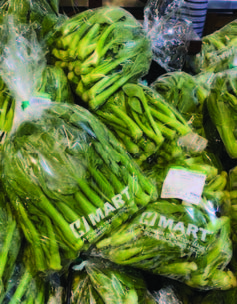



When you walk into an ethnic market, you’re bound to encounter a new food, or a familiar food presented in a new way. Play Marco Polo or Columbus or Magellan and explore. For instance, at Hmart, take a stroll through the produce department and you’ll find big and baby choys, musk melons and snow pears, honey apples and dragonfruit. Segue to the seafood department, and there will be icy bins of whole fishes and tubs of whole crabs.
At NetCost, there’s a selection of at least a couple dozen caviars, a sea of smoked fishes, and herring enough to satisfy a famished Norwegian. There are scores of different breads, various styles of sour cream, and preserves that transcend anything Smucker’s makes. You already know same-old, same-old. Challenge your taste buds
 Better Shop Around
Better Shop Around
Some of the markets in this story are located in towns near you, so you know about them already. Take note of those that aren’t…if you are traveling to another part of New Jersey for business or pleasure, take the opportunity to stop in and explore. Most are on or close to major roads and highways
NetCost • Manalapan and Paramus
Hmart • Paramus, Cherry Hill, Fort Lee, Edison, Leonia, Ridgefield
City Fresh • Union City
Seabra Foods • Newark, Kearny, Harrison
Mitsuwa • Edgewater
Patel Brothers • Edison, Iselin, North Brunswick, Parlin, Plainfield, Perth Amboy, Trenton, Pennsauken
Kam Man • Edison, East Hanover Chowpatty • Iselin
Fattal’s • Paterson
Nouri Brothers • Paterson
Piast • Garfield
Makola African • Newark
The Greek Store • Kenilworth
Andy Clurfeld, who racked up a lot of miles for this story, notes that while we do take-out from our favorite restaurants—while we support them in any way we can right now and as the future unfolds—eating more adventurously at home today will make all of us more appreciative diners when our eateries are again at full capacity. “If there’s one thing I’ve been hearing from chefs,” she says, “it is that, in the post-COVID Era, they can’t wait to cook at full tilt. And then some.”

